Medical Aid for Palestinians
No Comment needed –
Simple, moving and straight to the point.
https://www.map.org.uk

Medical Aid for Palestinians
No Comment needed –
Simple, moving and straight to the point.
https://www.map.org.uk
In the dog days of the post sixties excitement, popular music after Led Zeppelin slowly descended into the prog rock abyss. I am probably referring here to something like the double album Tales of Topographic Oceans by Yes (1973), despite the fact I had loved The Yes Album (1971). Casting around for something new to listen to I bought my first purely instrumental album, Freedom Is Frightening (1973) by Stomu Yamash’ta. It helped that I had seen an exceptional live show by his Red Buddha Theatre at Liverpool University, and now I was ready to listen to a whole album without lyrics, without what I called songs. Of course I had heard and loved Kind of Blue by Miles Davis, but at the time I only bought contemporary albums. I became a librarian much later.
I am not sure which ECM album I bought first but it was either Belonging by Keith Jarrett (1974) or Solstice by Ralph Towner (1975). It doesn’t really matter since they both heavily feature Jan Garbarek on saxophone, who became the lodestar of my new music obsession. It wasn’t as much fun as rock music, since no-one I knew had ever heard of any of these people. Not only that but this music had a lonely, plangent quality, a spiritual essence and purity which encouraged solo, contemplative listening.
At the time the clarity of the sound led to it being called chamber jazz. This was meant to be demeaning, that is lacking the funk, the blues of “real jazz”. Yet we can see now, with ECM progressing into its 55th successful year, that they were in fact creating a new genre that even today sounds unique. Try saying they weren’t “funky” when you hear the emotion pouring out of Jan Garbareck’s saxophone on Nimbus (from Solstice), for example. Also they were running against the grain, this was primarily acoustic music, there was no electric rock in this jazz. To this day it is my greatest pleasure to hear real music, that is music played without processing, on a real instrument, played by a master who talks directly to me. Although of course in this case it has been beautifully recorded by Jan Erik Kongshaug, produced by Manfred Eicher and pressed onto vinyl. Yet there is no doubt ECM records had a clear and ageless acoustic of their own, which they maintain to this day.
As time went on these two albums opened up a new world, featuring as they do a series of artists who branched out to make their own albums, although only a few matched up to these two initial recordings. From this moment on ECM records became a unique touchstone in my life. I did splash out on the 3 disc box set Keith Jarrett Solo Concerts Bremen/Lausanne, but later much preferred The Köln Concert, it is a lot crazier, yet more direct. Keith Jarrett was also the pianist for another much played album back in the day, Gnu High (1976) by Kenny Wheeler, along with Dave Holland and Jack DeJohnette. A few years later Eberhard Weber, the bassist on Solstice, went on to make Later That Evening (1982), which became a firm favourite. I used to buy this record as a present, to demonstrate the wonders of ECM to my friends, not always successfully. Later That Evening also introduced me to the guitarist Bill Frisell, who for a brief period of time became an ECM artist and recorded extensively with Paul Motian to great effect. Ralph Towner formed the group Oregon with Paul McCandless, Glen Moore and Collin Walcott, recording for both Vanguard and ECM, but managed to keep the same aesthetic. And then of course Collin Walcott formed Codona on ECM with Don Cherry and Naná Vasconcelos, the family tree continues to grow. You end up buying a lot of records!
Jan Garbarek meanwhile went on to record a plethora of great albums for ECM, of which I Took Up The Runes (1990) stands out, not forgetting the atmospheric Magico trio albums with Charlie Haden and Egberto Gismonti. With his keening tone he always sounds like he is playing on some windswept cliff or at the end of a long fjord, it was a sound that redefined what jazz could become. Later on he made the unique and groundbreaking Officium (1994) with the classical male vocal quartet Hilliard Ensemble, which leads us neatly into the ECM New Series. This New Series is ECM’s classical label featuring both early and contemporary classical music. Albums of note, to me at least, include Music for 18 Musicians by Steve Reich and Tabula Rasa by Arvo Pärt. ECM albums may have some of their unique quality due to the way Manfred Eicher chooses to work. Normally he will record for two days, mix on the following day and that’s it. This lends the albums a fresh, concentrated and improvised feel, the quality may vary, but as we know he does not release everything that is recorded.
There is no doubt that Manfred Eicher and ECM (which stands for Edition of Contemporary Music) redefined the meaning of jazz, enlarging the spiritual and universal qualities of the music. You only need to take a look at their roster since the first release in 1969 by Mal Waldron to see it now encompasses everything from the raucous Art Ensemble of Chicago, the masterful Tunisian oud player Anouar Brahem to the Greek soundtrack composer Eleni Karaindrou. This music is not defined by genre or tradition but a certain seriousness and elevating intent, their motto being “the most beautiful sound next to silence”. In addition they are a family, projects are often made by combining disparate influences, the musicians are tested and exercised by the unusual combinations set, I presume, by Manfred Eicher or Steve Lake. Thus new and original music is made, long may it continue.
This blog was partly inspired by the review of four new ECM albums by Richard Williams on his own blog thebluemoment.com. In fact it could easily have been his own reviews in Melody Maker back in the early 70s which prompted me to buy Belonging and Solstice in the first place!
I passed my exam (a bit like A levels) to be awarded a WSET Level 2 award in Wines (with Merit) last year. To get to the next level can cost up to £1000 so I won’t be doing that, but nevertheless my Level 2 course was both interesting, tasty and informative. I believe I can now be called a sommellier, but that does not guarantee I know what I am talking about. The WSET stands for the Wine & Spirit Education Trust, and they run lots of professional and expensive courses.
Still to get to the meat of this blog I will provide some recommendations and preferences. Illustrated above is my bargain wine of choice, Famille Perrin Côtes du Rhône Réserve. It is both simple, classic and blended (60% Grenache, 20% Syrah, 20% Mourvèdre), available on discount for about £10 if you’re lucky. This wine immediately shows my preferences, it is deep, brambly, confusing and peppery. Most normal Côtes du Rhône are a bit light, that is they feel a bit watered down to me. However this Réserve and the Vinsobres version are the real deal. A cheapo version is La Vieille Ferme by the same Famille Perrin, available nearly everywhere for £8. Further south and more classic is Chateauneuf du Pape, but that costs £30 a bottle and so it is out of my price range. My tip is to go next door and avoid the classic names. Yes, nearby in the Southern Rhône you will find Gigondas, still quite expensive, but look out for Rasteau, Lirac and Cairanne, snap them up if you find them. As you maybe know French Appellation Controlée wines are based on terroir, that is where it is grown, yet the field next door may be just as good.
Going further afield I have a particular preference for Carménère, an ancient grape which was wiped out in France by the phylloxera bug in the 1880s. Now it is grown mainly in Chile and has a particular dark chocolate and tobacco flavour. You can’t find it in France, although it blends well with Cabernet Sauvignon, of which it may be a varietal. For many years the growers in Chile thought it was Merlot, how wrong they were!

In fact there is a vast amount of confusion over grape varieties even by the growers, and modern genetics has shown how similar, if not identical, many varieties are. For example even the relatively unknown Carménère has over 40 different names, and never forget Shiraz and Syrah are the same grape. It is a confusing business. Wines grown and matured around the world can taste very different, even if they are they are made from the same grapes. In general I find most red wines from Australia and South Africa too sweet or too fruity, so usually I do not recommend them. That is just a personal, unfair and blanket preference.
So part of the joy of tasting wines is in fact the difference. Every bottle is an adventure. Yes they all taste like wine hopefully, but some sure are better than others. If I see an unknown grape variety I always want to try it, leading to some great discoveries and a few disappointments. These wines tend to come from Eastern Europe or Greece. Like any decision this is partly based on circumstance, mood and maybe even time of day. Many times I have tasted a glorious wine, only to feel misled when tasting the following day, good wine needs a moment to bloom, secure those moments…
To get back to advice, I would personally recommend a Malbec if you are in a pub, it is so reliable and tasty. In fact any wine from Chile or Argentina is usually good value and full of flavour. Next on the value list are the blended wines from Southern Portugal and then maybe Primitivo aka Zinfandel (same grape again), or Nero d’Avola from Italy. These wines are all strong in flavour, but if you prefer something lighter like strawberries try a Pinot Noir from Chile or even New Zealand. Burgundy, usually very expensive, is made from the same Pinot Noir grapes in North East France. All the advice so far is for red wines, but I do have some White favourites. Number One is Viognier, maybe from Chile or France, and then I do like a rich Chardonnay from Australia. Remember despite being once very popular and hence not trendy, Chardonnay is a cheap Chablis, so enjoy!
{}
The Lad from Tad
This is an audio panorama of Paul Shearsmith playing with KMAT at the Hundred Years Gallery in Hoxton on the 17th November 2012. It was to celebrate his car, a Volvo Amazon 131, which he had made into a full size photograph taken by me and mounted onto laser cut plywood. This ended up costing more than his actual car! It was exhibited at many venues around town including Printspace, Mario’s Cafe and Stoke Newington Assembly Hall. Later on the battered Volvo featured in a movie, it was some car!
From the minute I met Paul through my friend Giles Perring and the band Echo City we always got along and met up many times in the pub he helped save, The Pineapple. In fact, only the other day, I took another old friend there, passing the rusting Volvo Amazon, now missing a bumper, and pointed out the photograph of Paul playing his pocket trumpet, which is proudly displayed in The Pineapple. Our first collaboration was when I made a video from panoramas and stills for his track Iraq Attack back in 2006. I presume you can still hear the anger.
Yes Paul, along with his partner Bettina, was an activist, and we went to several demos together. Above you can see Paul playing a trumpet on a rainy day at a March for Homes demonstration in 2015, sponsored by Socialist Worker. But what I most remember is the joy and the laughter, the music and even the dancing. This mostly happened at Paul’s birthday around Guy Fawkes day, he always had a keg of real ale and some crazy music. Plus there were 2 New Years celebrations fondly remembered.
Still the best was yet to come. Bettina played saxophone with several big bands which I greatly enjoyed and then out of the blue Paul produced a song with the Dan Spanner Big Band which I loved – My Degeneration. I believe it was the only song they ever had a vocalist for (apart from Dan) and it was a dynamite rewrite of The Who’s My Generation. We made a video for it in half an hour before their gig at The Gunners, while the pub was still open. That was the only time the band were actually all together, although we did a lot of prep beforehand to ensure our plans ran smoothly. This was the comment from the celebrated singer Maggie Nicols: I love this. I even joined vimeo so I could comment. It needs to go viral.!!
I saw Paul play many times, in many different groups. He was always experimenting, whether with saws, hosepipes, plastic trombones or pocket trumpets. It was always a delight, yet he always listened and could be quite diffident onstage, the mark of a true musician. Going through my archives I found this Test Video which I have never posted, taken at Alan Wilkinsons Film Flam club in Stoke Newington in 2020. It features a group called Bubble with Keisuke Matsui on guitar and Adam Bohman on objects. I hope it it reminds you of what a remarkable person he was. Thanks Paul!
†
When I grew up in the 60s youth culture was hard to find. Now that it is everywhere it seems strange to remember what hard work it was to find it. But that certainly did make it seem more personal and a real adventure of discovery, these things were well hidden. There was no record player in my house so, for example to hear the Beatles, the only chance was random moments sifted out of the humdrum BBC boredom. Funnily enough request shows like Family Favourites aka Forces Favourites on the BBC Light programme would play the Beatles occasionally, as did the chart show Pick of the Pops and Saturday Club. But these shows were on just once a week. There was no pop music radio station until the Pirates came along in about 1965. So it was with great excitement that I found Radio Caroline North on 257m Medium Wave, however that didn’t last long, since they were closed down by the Marine & Broadcasting (Offences) Act 1967. Radio 1 then arrived to replace the Pirates, using many of the same DJ’s, but I refused to listen for some time since I was so annoyed by the closure of Radio Caroline. It had felt like a radio station just for me and, despite the ads, was dedicated to the music . Eventually I purloined an old valve radio from my grandparents. It was large and heavy, mains powered and took several minutes to warm up. Yet it was in a cool bakelite case and had a 5 inch speaker, as shown above. On this ancient radio I discovered Radio Luxembourg on 208m, in particularly David “Kid” Jenson and his progressive music show, usually broadcast every weekday at midnight from October 1970. Here I heard The Band, Lou Reed and Neil Young for the first time and made many musical discoveries. There was a lot of staying up late, but the big radio sat right by my bed, glowing in the dark. The only comparable programme on Radio 1 was Top Gear with John Peel, broadcast just on a Saturday.

Despite not having a record player or radio for many years I did come into possession of an early Grundig dictaphone. It had been given to my father as a business gift, but since he didn’t use it I eagerly adopted it. This was a tiny (c.125cm) Mini Cassette Voice Recording Dictaphone, similar to the one illustrated. This amazing machine was really an early cassette player, too small and tinny for music, but great for the radio. I had just one tiny cassette for it (I did not realise you could buy any more!) which lasted for 30 minutes. Still I put it to good use, recording the classic BBC Radio 2 comedy I’m Sorry, I’ll Read That Again, so my cassette was exactly the right length. Having recorded the show I would listen chortling under the bedclothes at night. And of course I could replay any great joke I had either misunderstood or greatly appreciated. I wiped and then recorded the next show until the poor little tape wore out, while receiving an education in outlandish humour still with me today. The line-up of the show was John Cleese, Tim Brooke-Taylor, Graeme Garden, Jo Kendall, David Hatch with script input from Graham Chapman and Eric Idle, so as you can see it contained the roots of Monty Python, all of the Goodies and was responsible for the still running I’m Sorry I Haven’t a Clue on Radio 4.
Monty Python’s Flying Circus would go onto becoming the defining comedy show of my youth. An early introduction to this zany type of humour had been Do Not Adjust Your Set featuring the magnificent Bonzo Dog Doo-Dah Band, on ITV 1968-9, ostensibly a children’s programme. From this show Eric Idle, Terry Jones, Terry Gilliam and Michael Palin went on to join Python along with John Cleese and Graham Chapman, which started on the BBC in October 1969. At school we loved them so much we invented a fake religious assembly involving lining up, flipping the radio socket and shouting “Dinsdale” as gruffly as we could. This was performed just before the actual school assembly to put us all in a stupid mood. Dinsdale was one of the gangland Piranha brothers and a very naughty boy, haunted by an 800 yard long hedgehog called Spiny Norman. I also had the privilege of seeing Monty Python’s 1st Farewell Tour at Liverpool Royal Court Theatre in 1973 (although we knew all the jokes) and to appear as an extra in Monty Python and the Holy Grail in 1975. Only last year I sang Rockin’ Around the Christmas Tree in a choir for Michael Palin, the comedy never ends…
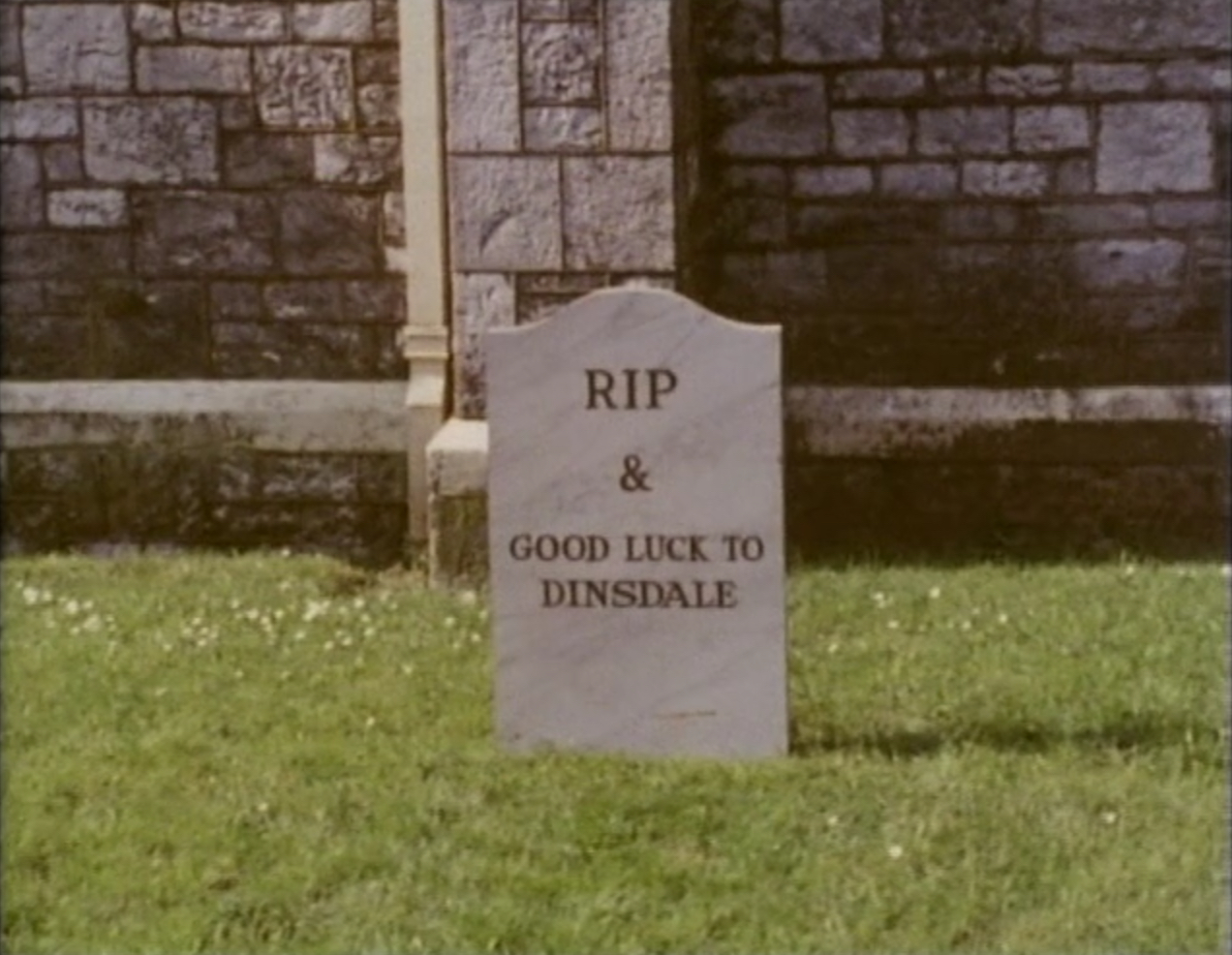
On Sunday 27 October I saw the Otomo Yoshihide Special Big Band at Cafe Oto. This 17 piece ensemble from Japan played the gamut of modern big band music, starting off with the stomping rhythm of Stone Stone Stone (I believe). One of the glories of this orchestra is that it functions as separate bands within the band, the sectional conductors calling out changes for their own ensembles. This makes for great excitement and dynamism, a feeling that each moment, each break is special. During the evening they covered nearly every known genre from French Romanticism to Northern Soul, I heard the systems music of Steve Reich for a few bars, and plenty of Sun Ra, spinning off into atonal galaxies. You never knew what was coming next, yet it was all held together, with the great joy and happiness evident within this big band.
It took me some time to appreciate big bands, they seemed too amorphous and maybe old fashioned, belonging to a previous generation. I was brought up on The Beatles, you could hear what everyone was doing, and hear exactly how they all worked in unison and why every component was vital. They had the power of amplification on their side to make even four people sound like an orchestra. However before electrification and the public address system took over, all bands had to be large, simply to make enough noise to fill the hall. So back in the 30s big bands ruled the roost and they played acoustically. That now seems admirable to me, I want to hear the musician, not the processing. So what is a big band? Basically it should contain at least 10 performers and a brass section, that is the limit of my definition. It is a very open category, the keynote being dynamic excitement.
Probably the first big band sound I loved would be the fabulous arrangements by Nelson Riddle for Frank Sinatra, without even thinking they were a big band. I got into a great deal of trouble at Sounds (a rock music weekly) for making Songs for Swinging’ Lovers (1956) the No. 3 in my Top 10 albums of all time, which meant it would have appeared in their Top 100 – I had to remove it! While that album may have been too jolly for Sounds, I wonder if my first truly memorable gig by a live big band, Sun Ra at The Venue in 1983, would have been acceptable with the album Jazz in Silhouette (1959)? I was to see the Sun Ra Arkestra at Cafe Oto many more times from 2009 to 2014, cementing my love of this music. In fact thinking back, I had bought Escalator over the Hill by Carla Bley in 1972 while still at school, yet I did not even think of this as jazz or big band at the time, more like experimental rock featuring Jack Bruce. I guess what made these records acceptable was the pulsing and dynamic rhythm section, after all big band music was originally made for dancers.
In my pantheon of great big bands there many are I have discovered over the years. You can’t go wrong with anything by Duke Ellington, and my first choice of his would be Ellington Uptown (1952) featuring A Tone Parallel to Harlem (Harlem Suite). Another great modernist composer is Stan Kenton, you can hardly believe this music was made back in the early 50s, and albums such as Innovations in Modern Music (1950) feature a 37 piece orchestra with a 14 piece string section. Following up on some of Kenton’s inventiveness there is Don Ellis who brought a swaggering 60s feel to big band music, and if that’s a bit much try Gil Evans, famous for his work with Miles Davis. A contemporary acolyte of Gil Evans, who has also worked with David Bowie, is Maria Schneider with several Grammy Awards to her name – check out Data Lords (2020).
Closer to home there is the fabulous Spanner Big Band, playing modern arrangements of 50s classics from Mingus, Ellington and Basie as well as a few reorchestrated pop tunes. They are led by the dynamic Dan Spanner and regularly play at the Three Compasses in Hornsey for free. Also recommended are Orquesta Esterlar, a community-based Cuban big band, playing monthly at The Post Bar in Tottenham, and that’s free as well. So do go along…it’s always a privilege to see a crazy big band and financially these days they are performing for the love of it. You can tell from the smiles, on your face and theirs.
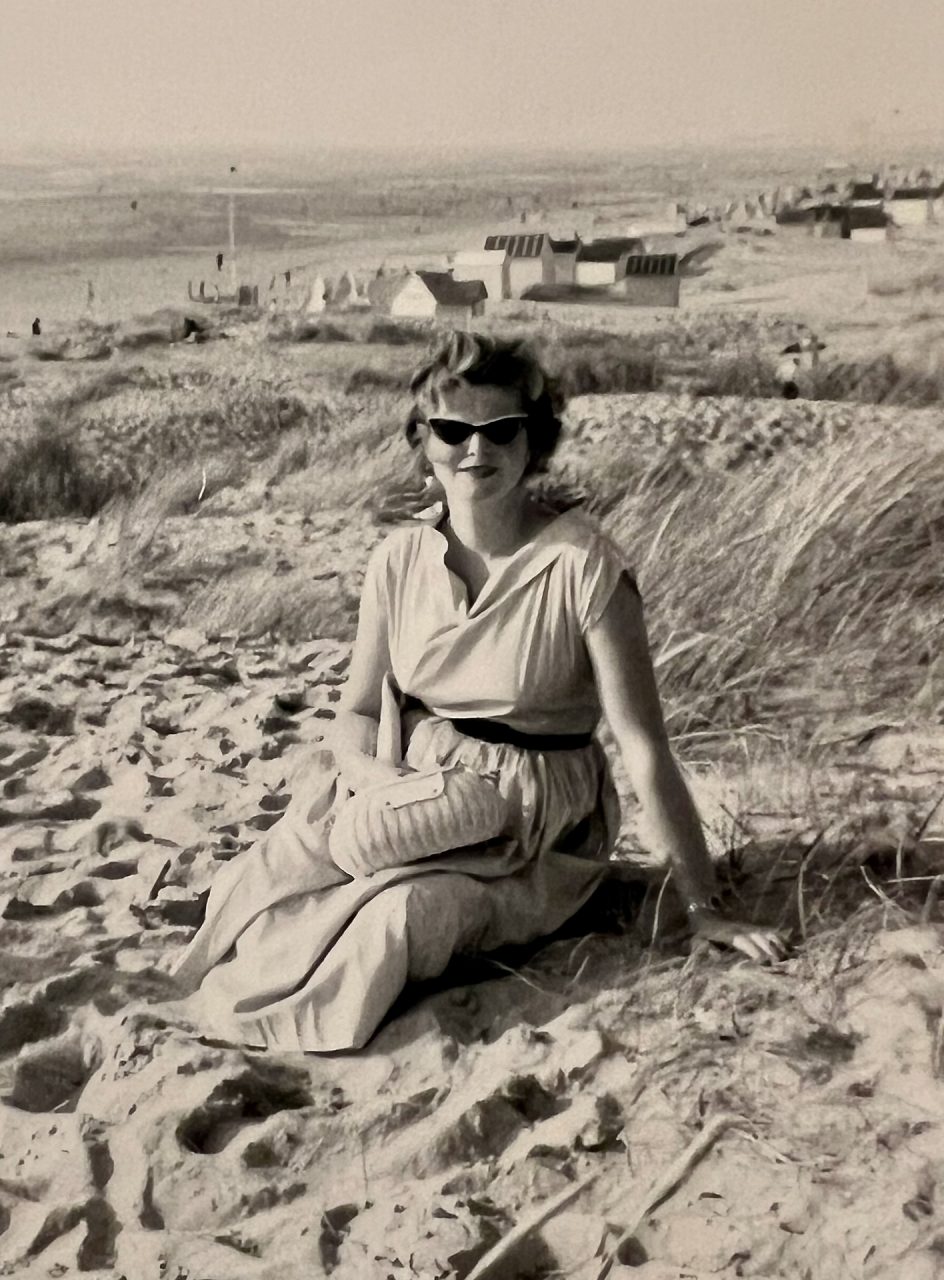
My Father and Godfather committed suicide. That was their privilege, they were Doctors. They knew they were terminally ill and they had access to the relevant drugs, and so did not need to involve a third party, which would be currently illegal. They assisted their own dying. In fact, my Father failed the first time, which shows just how difficult it can be. Don’t forget providing information, advice, support or assistance to anyone intending to take their own life is against the law. Until 1961 attempted suicide was itself a crime, leading to prison and loss of all goods.
Unfortunately, my Mother, who had made it clear through several documents such as a Living Will and DNR (do not resuscitate instructions) that she did not wish her life to be prolonged, lived through 6 months of Hell. She also had a sympathetic local doctor and had already refused further chemotherapy for breast cancer. All of this appeared to make no difference. At her lovely hospice, I was told by a tearful doctor my Mother would die within 2 weeks. Sadly my Mother survived too long and was ejected from the hospice, and had to be placed in a retirement home, which turned to be a very unpleasant experience for us all. She fervently wished for assisted dying for that 6 months. Despite trying not to eat, she lived too long for a happy ending. I blame our outdated legal system.
Thus to say I support assisted dying would be an understatement. Of course at my age I’m already worrying about my own lack of choices. Assisted Dying is a right which should belong to us all. Thank you Jonathan Dimbleby, Julian Barnes, Patrick Stewart, Jo Brand, Prue Leith and Esther Rantzen for raising the profile of Dignity in Dying.
As Prue Leith says “While I am healthy at the moment, I’d very much like to have a little lethal concoction sitting in a safe waiting for the right moment. And I’d rather it was legal.”
Update 30/11/24
Hurrah!

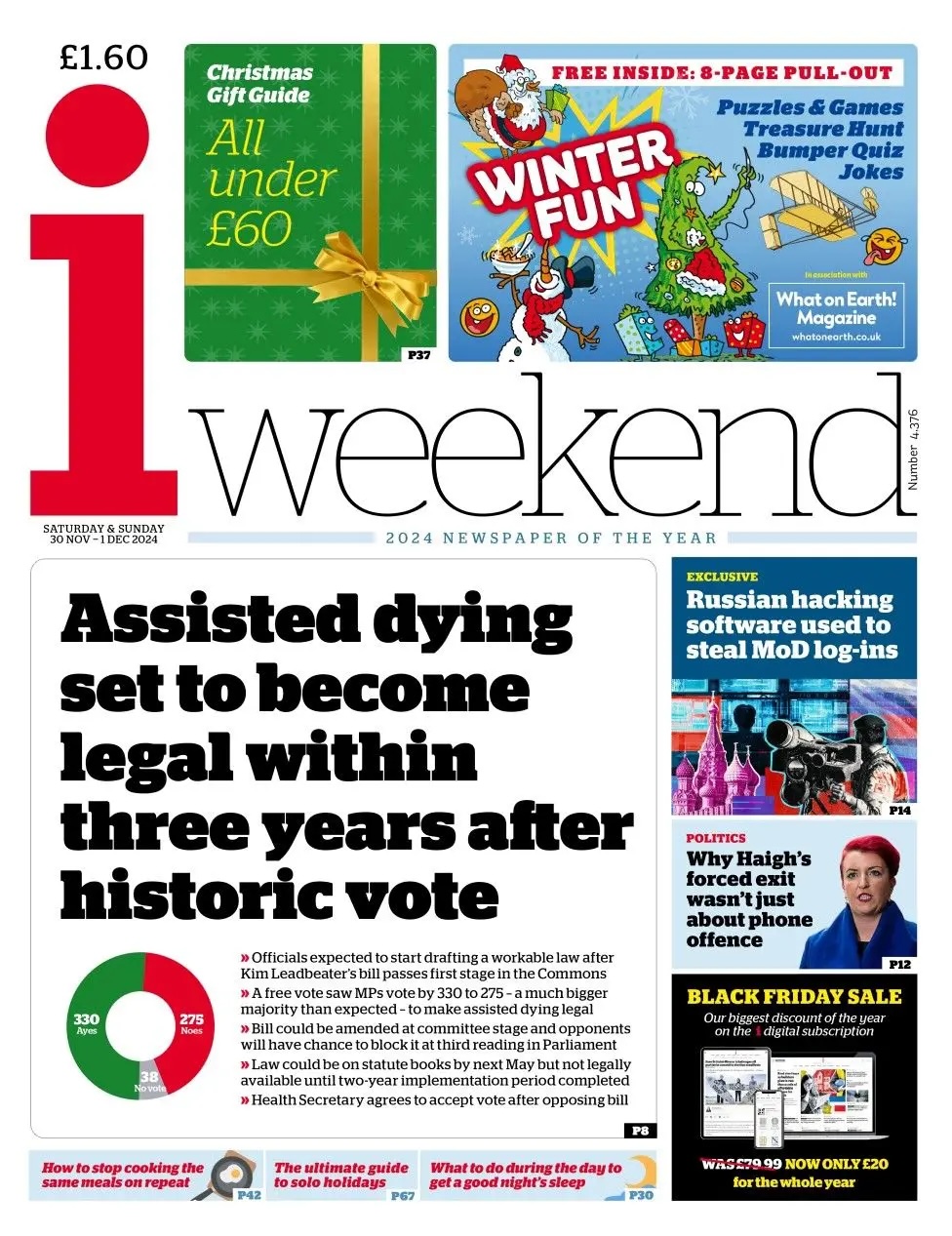
†
It is beyond my comprehension why anyone who is not a millionaire would vote for the Tories.
Still there are only 2,849,000 millionaires in the UK (4.8%), not enough to win an election.
But people still vote for them – At least for the last 14 years.
Shows how much I know…
I Saw Keir Starmer speak in 2014 before he was an MP for Holborn & St Pancras (aka Camden).
He answered every question at Camden Girls School better than anybody.
I told my hairdresser (who also held a hustings, see my video) he would be the Prime Minister one day.
I believe I will be proved right.
Personally I will be voting Independent.
The Labour Party is a War Party.
Nuclear weapons can destroy the World.
Hence I do not vote for them.
I hope that is not a surprise.
Happy Voting!
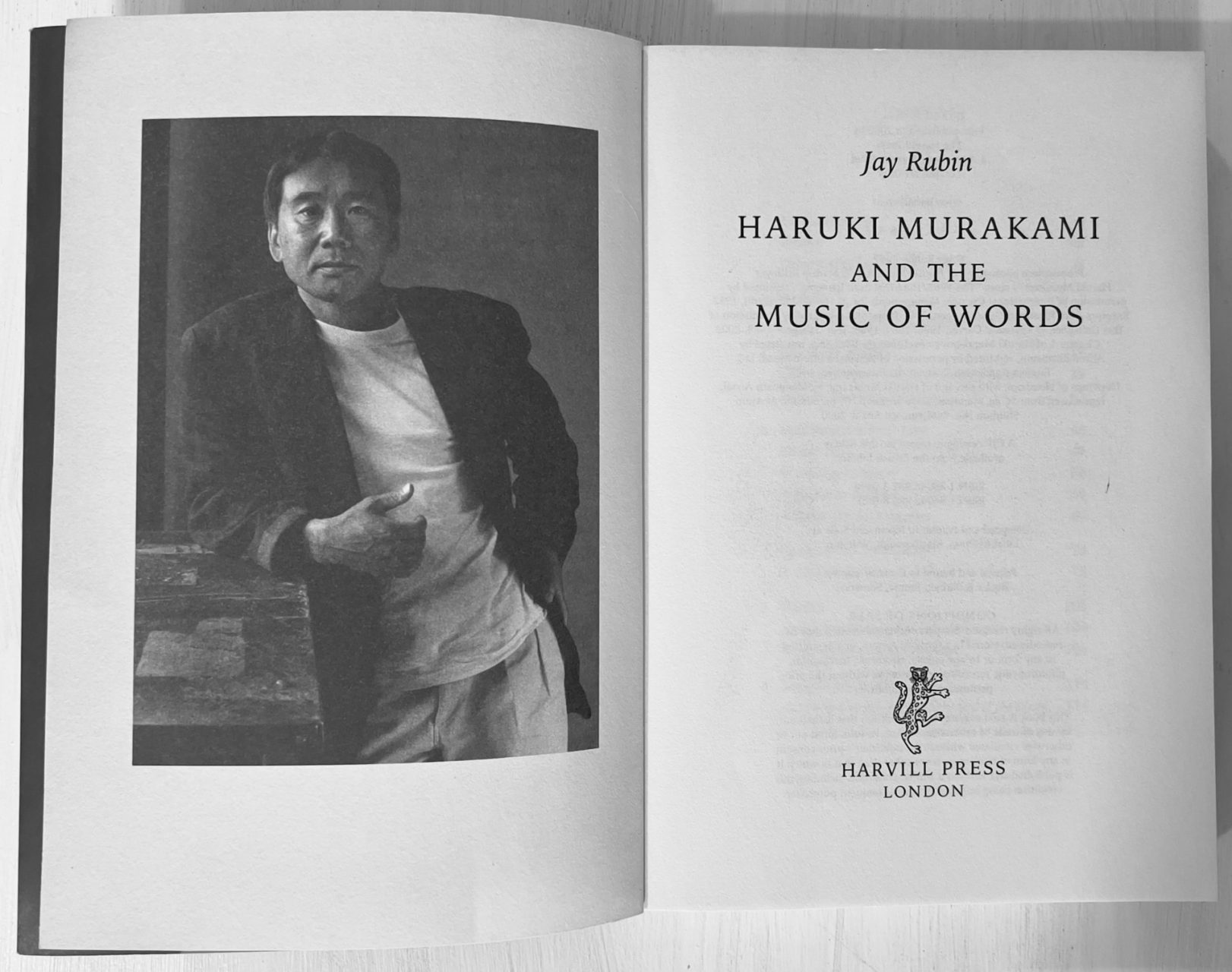
I can’t remember when I first came across Murakami, but it was some time in the early 90s, probably his 3rd novel A Wild Sheep Chase (1982). From that first reading I was hooked, entranced by his surreal imagination, the contemporary view of Japanese society and his wide ranging and accurate musical references. You could tell you were taking off on a wild careening ride, destination unknown. In fact this is the way he writes, the novel expands autonomously as he works on it, yet he nearly always manages a satisfying conclusion. As he says “writing itself is like dreaming”. To me this makes him a truly modern novelist, you don’t feel manipulated by the characters and events, the door is ajar and there is simply a sense of mutual exploration. The often bizarre characters grow organically, reacting to strange events in a totally plausible way. These are open books, there is no predestination. He manages this because his writing style is somewhat prosaic, relating them in a very down to earth way, however bizarre they might be.
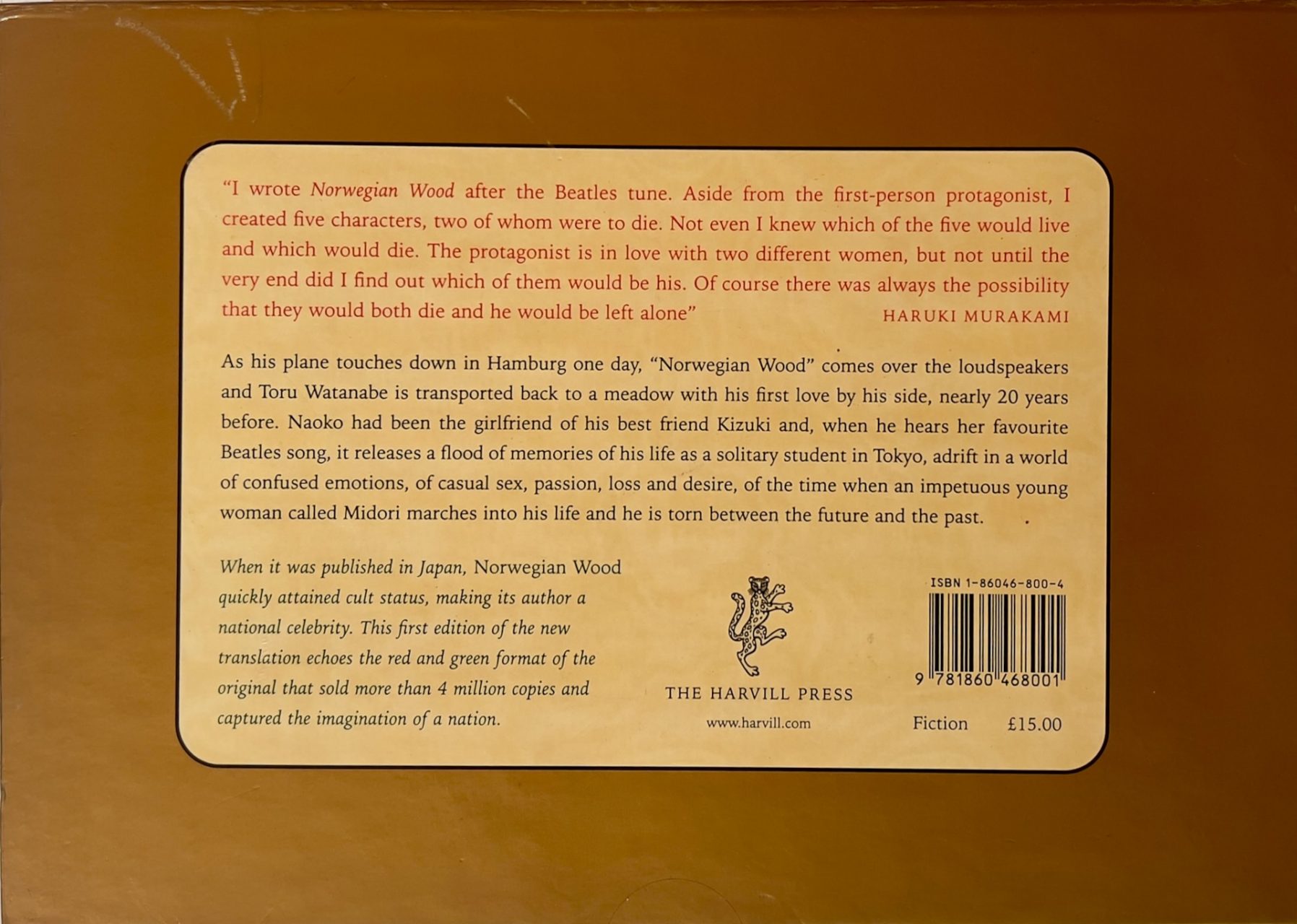
This unique style is probably down to the fact he never intended to be a novelist and certainly never trained to be one. He found his own unique voice, he explains in Novelist as a Vocation (2022) , by writing in English and then translating this back into Japanese. This gave him the simplified, pared down and highly readable style we know today. He is not in any literary tradition, which lends him an honest and personal voice. In fact the story of how he became a novelist, which he has told several times, could come straight out of one his novels. At the age of 29, he was running his own small jazz club called Peter Cat, when he went see his favourite baseball team and…
The satisfying crack when the bat met the ball resounded throughout Jingu Stadium. Scattered applause rose around me. In that instant, for no reason and on no grounds whatsoever, the thought suddenly struck me: I think I can write a novel.
I can still recall the exact sensation. It felt as if something had come fluttering down from the sky, and I had caught it cleanly in my hands.
After the match he bought writing paper and a pen and proceeded to write every night for six months, producing his first novel Hear the Wind Sing (1979).
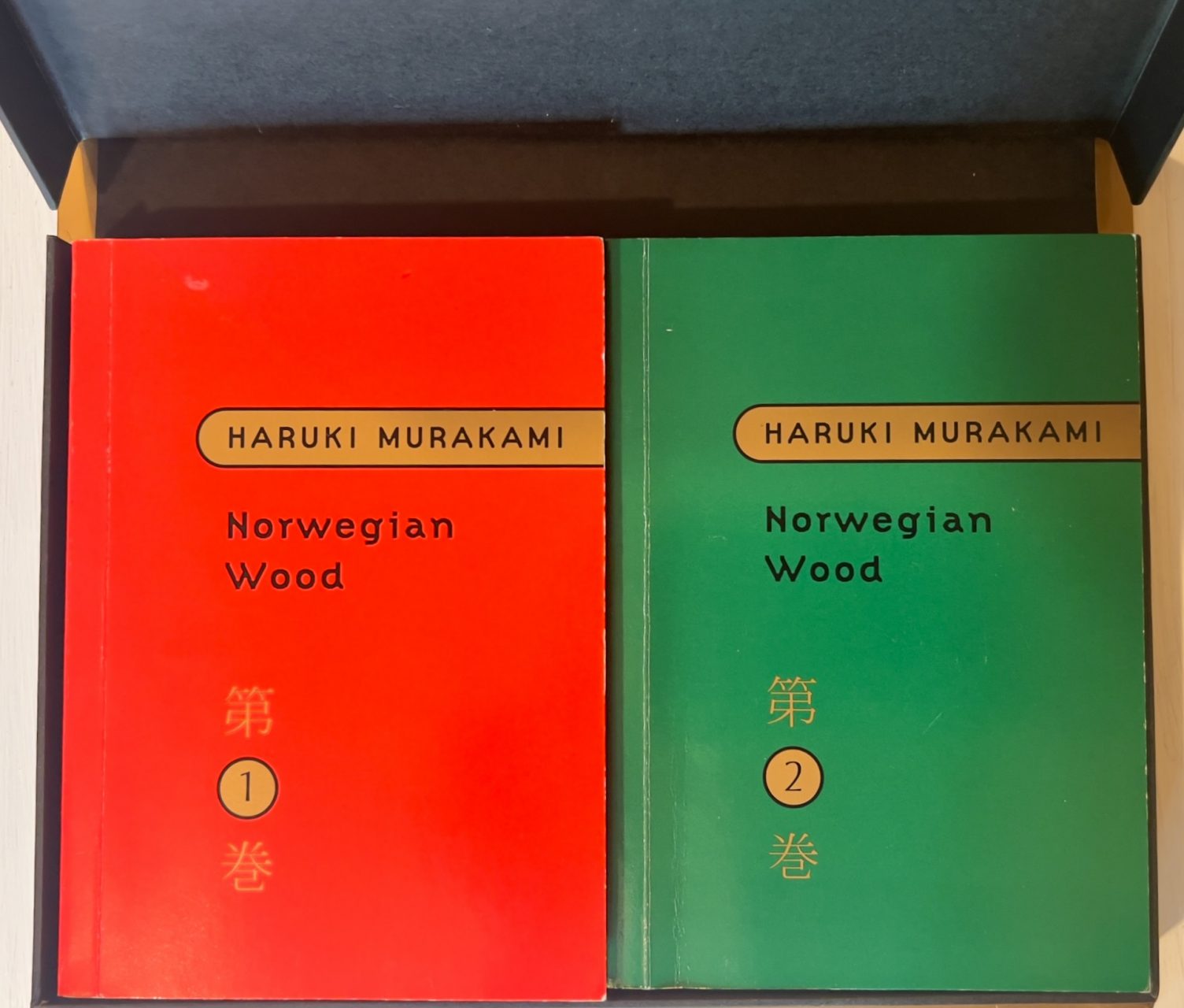
Before he became well known in the West, I always felt that Murakami readers were like a secret club. If in conversation with someone unknown and the subject of his books arose and they had read them, a mutual friendship seemed assured. A particularly bizarre experience of this nature happened in Northern Armenia. The country was suffering at the time from a complete breakdown, the Russians had left a few years previously, leading to the closure of farms, factories and even the education system. Nobody seemed to know who ran anything, people were just getting by in unregulated chaos. I was reading Hard-Boiled Wonderland and the End of the World (1985), a surreal cyberpunk novel about a crumbling walled town. There were many strange parallels between the book and the situation I found myself in and Murakami has stated that “I was so popular in the 1990s in Russia, at the time they were changing from the Soviet Union – there was big confusion, and people in confusion like my books”. Anyway to my surprise, one of our drivers (in fact from Syria) had read some Murakami, so I had leave my copy of the book with him, it seemed both appropriate and fair in the strange circumstances.
The lack of pretension combined with the acid and surreal wit in Murakami’s work, often makes me reflect on the similarity to British writers like Charles Dodgson aka Lewis Carroll, J.G. Ballard and even Brian Catling. There is an unusual symbiosis between Japan and the UK as islands at the end of continents, which perhaps leads to a unique form of isolated irrationality, as well as a secret understanding of the others situation. While his authorial voice can always be heard, his novels are quite varied, and he appears to have great fun with the design, Norwegian Wood (1987) appearing as 2 small volumes in a box, 1Q84 (2010) had a heavy black burnt look and Killing Commendatore (2017) had bullet holes on the cover. He always entertains the reader.
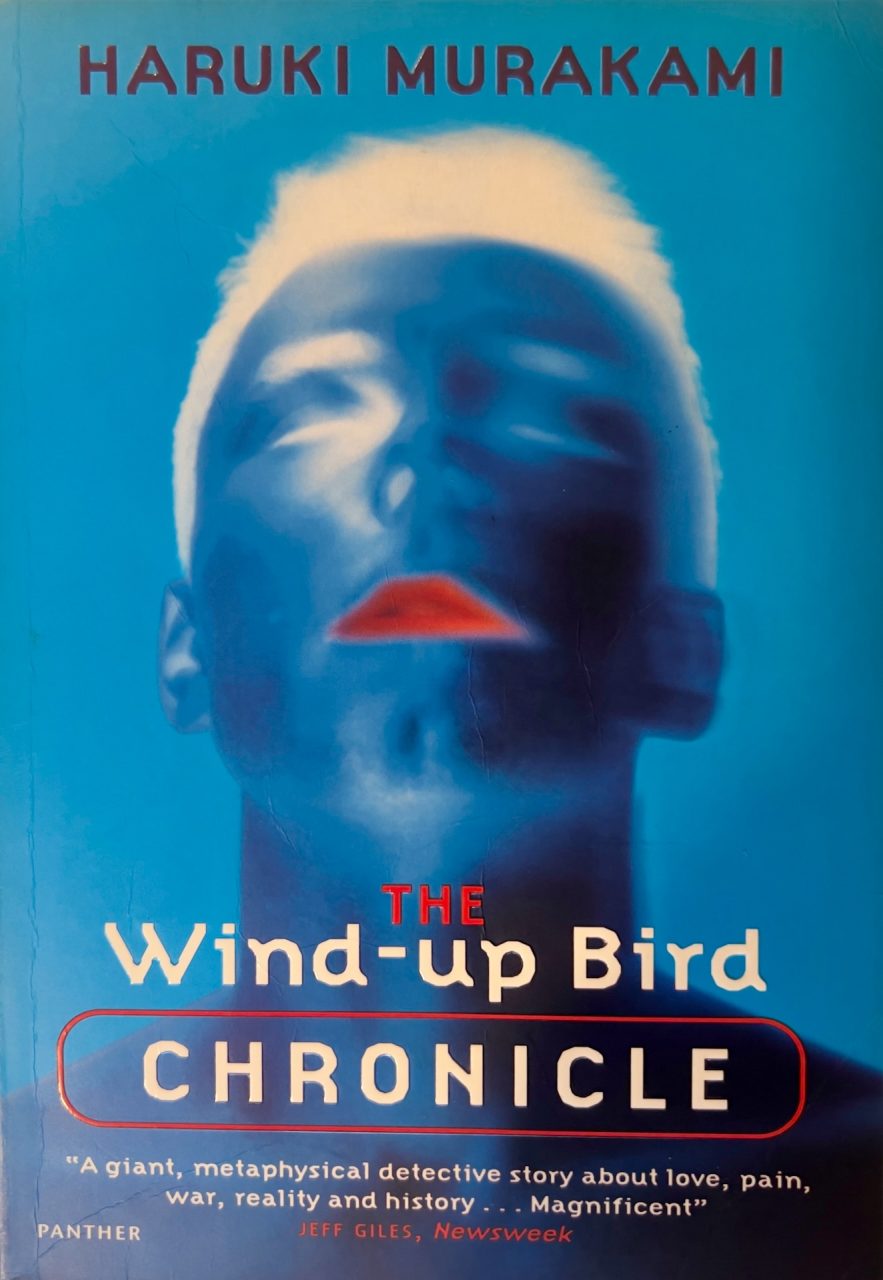
My admiration for Murakami was cemented by perhaps his greatest novel The Wind-Up Bird Chronicle (1995). If you read only one of his novels, this is the definitive one, for me at least. Shortly after this I read Haruko Murakami and the Music of Words (2002), a biography written by his translator Jay Rubin. Murakami had always been a quiet and mysterious character but this book revealed both his life story and the vast range of his output once he became an author. He writes translations of F. Scott Fitzgerald, Truman Capote, Raymond Carver as light relief from his novels, as well as a several collections of short stories, interviews and reportage. The novel Norwegian Wood (1987) which ensured his popularity in Japan and led to his living in the USA for several years, is charming, sad and maybe a little dated. Perhaps avoid 1Q84, it is huge and highly repetitive, but let me recommend nearly everything else. There are two semi autobiographical works What I Talk About When I Talk About Running (2007) and Novelist as a Vocation (2022), both of which are fascinating. All of his short story collections are highly entertaining and I thought his most recent novel Killing Commendatore (2017) to be a return to form. Looking forward to The City and Its Uncertain Walls due to published in translation later this year.
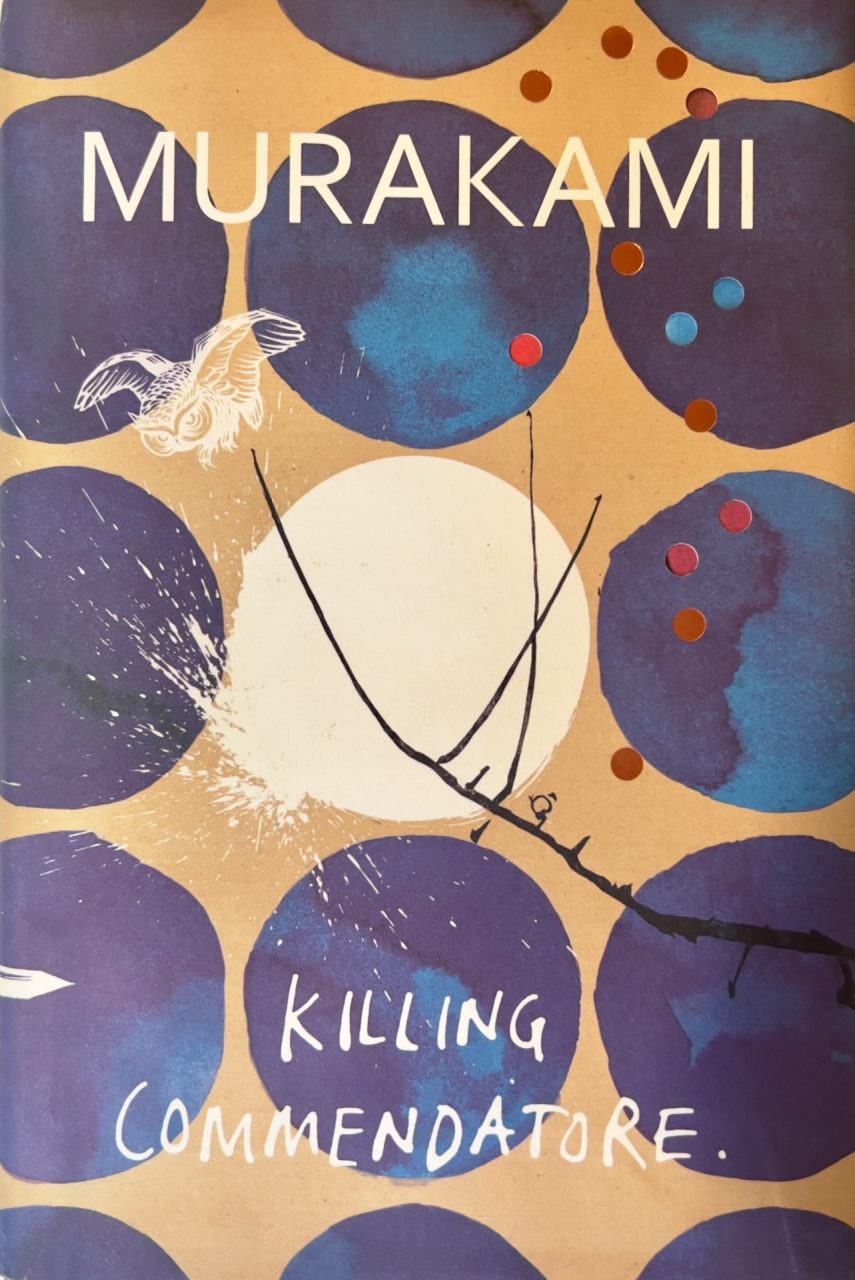
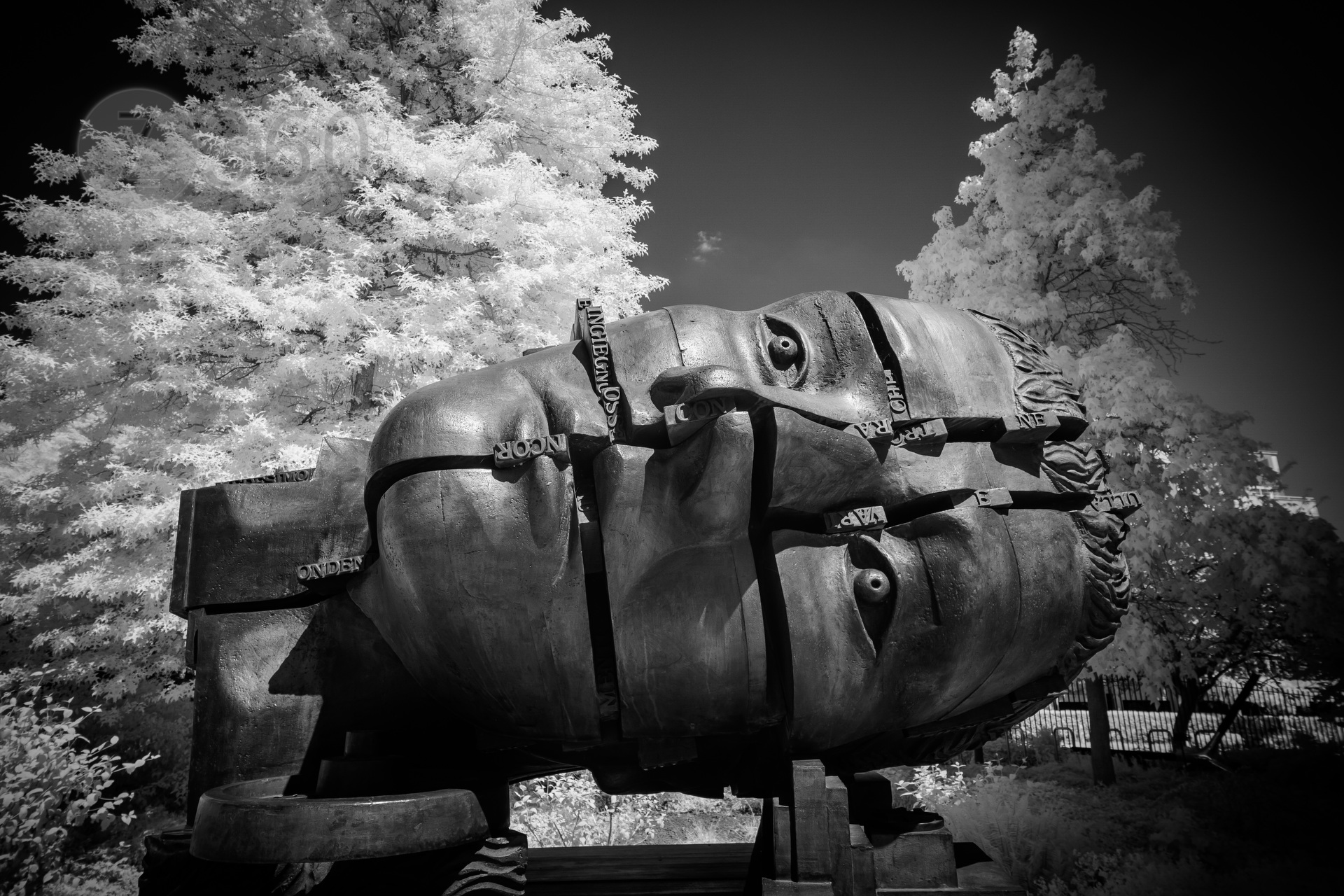
I have a bad memory. I know this because at the age of ten I had to remember the poem Froggie Went a-Courtin and repeat it to the class. This I failed to do and ended up bottom of the class at “Poetry” in my school report. Even now it takes maybe six months for me to remember people’s names, I seem to have a blank spot there. I work around it, and it requires special effort if I am forced to name someone, who may even be a good friend. However give me a hint, or even better a multiple choice question, and I will usually get the answer right. Hence I am pretty good at quizzes like Pointless or Michael McIntyre’s The Wheel. This was brought home to me when I did the first ever multiple choice O Level in Chemistry and unexpectedly got an A. My teacher was amazed and so was I, but show me the answer and I will do well.
I have maybe the best memory of anybody I know since I learnt the part of Iago in Shakespeare’s Othello, one of the longest in his whole magnificent oeuvre. I repeated this about twenty times on stage and very rarely used the prompt. I did have a method for when I got stuck, by substituting the word anything for the missing word, and nobody seemed to notice. To learn and remember all this, the role had to occupy my whole being and life, and for many months it was uppermost in my mind. At several points I thought the whole project was impossible, and I remember being on the top deck of a London bus, while trying to memorise lines, and realising I never would. Fortunately I was wrong, the mind is a bit of plastic elastic which can accommodate priorities and it is remarkably powerful. The bizarre end of this story is that I do not remember a single word of the play Othello, and would be hard put to even recognise any of those lines now.
The pain of learning lines is one of the reasons I gave up acting. Some people say they find it easy, but I never did. The role had to subsume me, take over my life and become an obsession. I found this an unpleasant trade-off. Once in a semi-pro production of Max Frisch’s The Fireraisers I was playing the lead character Mr Biedermann, and ended up comping or even inventing half the dialogue, since I hadn’t been given time to learn it all properly. Again nobody noticed, it was done with conviction! Personally I also had to revise dialogue on a daily basis if I was to remember it, and life is too short for that.
Now of course I am simply amazed I manage to remember anything, so I try not to. My mind is already full of stuff I am barely aware of or cannot access when I want, so I am trying to look after it. Does the mind ever get full I wonder, and certainly some of the rooms in this ever expanding mansion seem very distant. Yet it is a cave of treasures, constantly surprising me! This very blog is an example of random memory syndrome.
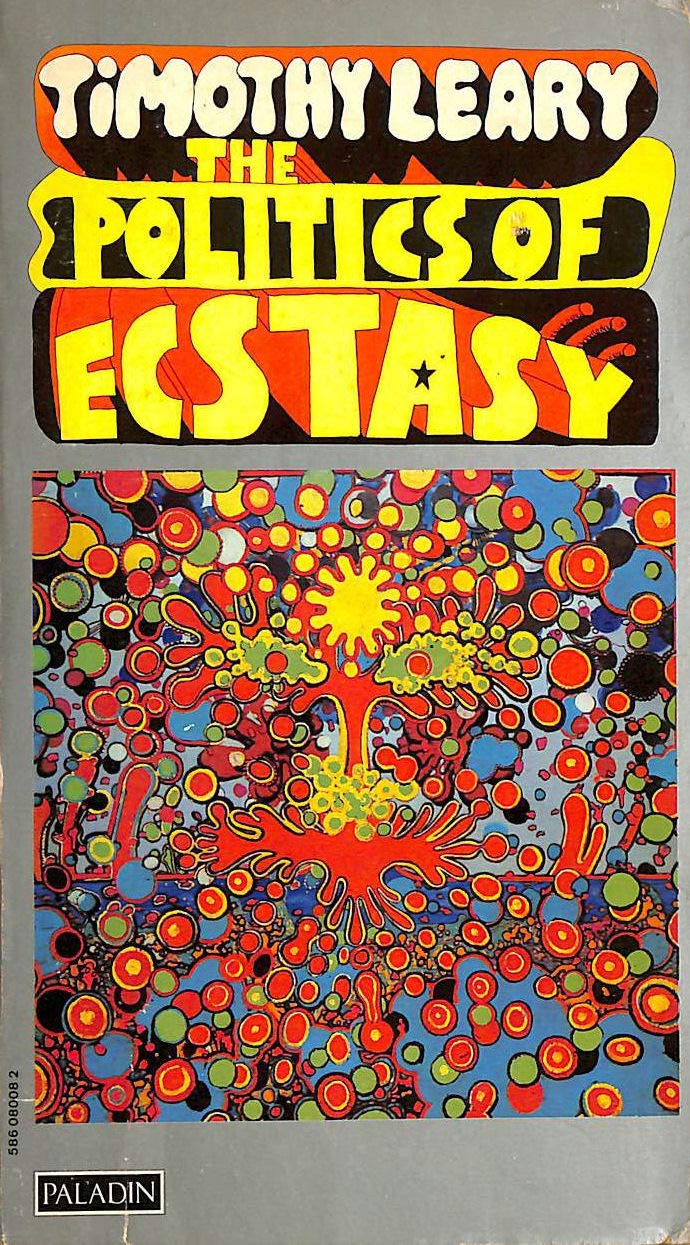
I read the book above in 1976, after I had taken LSD aka acid for the first time. It was a profound, yet relatively short lived experience. The book itself is an entertaining, if over the top read. Let’s not forget Timothy Leary was a well educated university lecturer with a Ph.D, he knew how to write, lecture and entertain. The Politics of Ecstasy was first published in 1966 in the USA and would become the foundational story of the late 60s hippie drug culture. It was first published in England in 1970, and I read it with a pinch of American salt, I already knew exaggeration when I saw it, yet it had an authority and intellectual chutzpah which was invigorating. I was already well aware of the profoundly spiritual and dangerous properties of this drug, having quizzed the few people I knew who had taken it, they had my admiration at the time. I had done my my homework, but nothing could prepare me for the reality. I believe it was on this first trip that I discovered how disorientating it could be, since I was at a concert in Pathfoot, Stirling University. Feeling spaced out, I realised I should be lying down and relaxing, so I departed early. As I was leaving through a long, large corridor I discovered I could rotate the whole corridor until I was walking on the ceiling. This was a great feeling until I start thinking too much about it and realised that this might not be a good idea since the corridor was not under my full control, it seemed to to have a mind of its own and I did not wish to fall to the floor – hey where is the floor, what is a floor, I thought gravity was supposed to exist, apparently now it does not… Most of Leary’s musings are based on The Tibetan Book of The Dead, and that should tell you before venturing any further that we are in dangerous territory. This territory was politely called a “bad trip”, yet it could destroy lives. We all knew what had happened to Syd Barrett, the former lead singer of Pink Floyd. For a good example of the foggy synaesthesia brought on by LSD, listen to his 1969 album The Madcap Laughs.
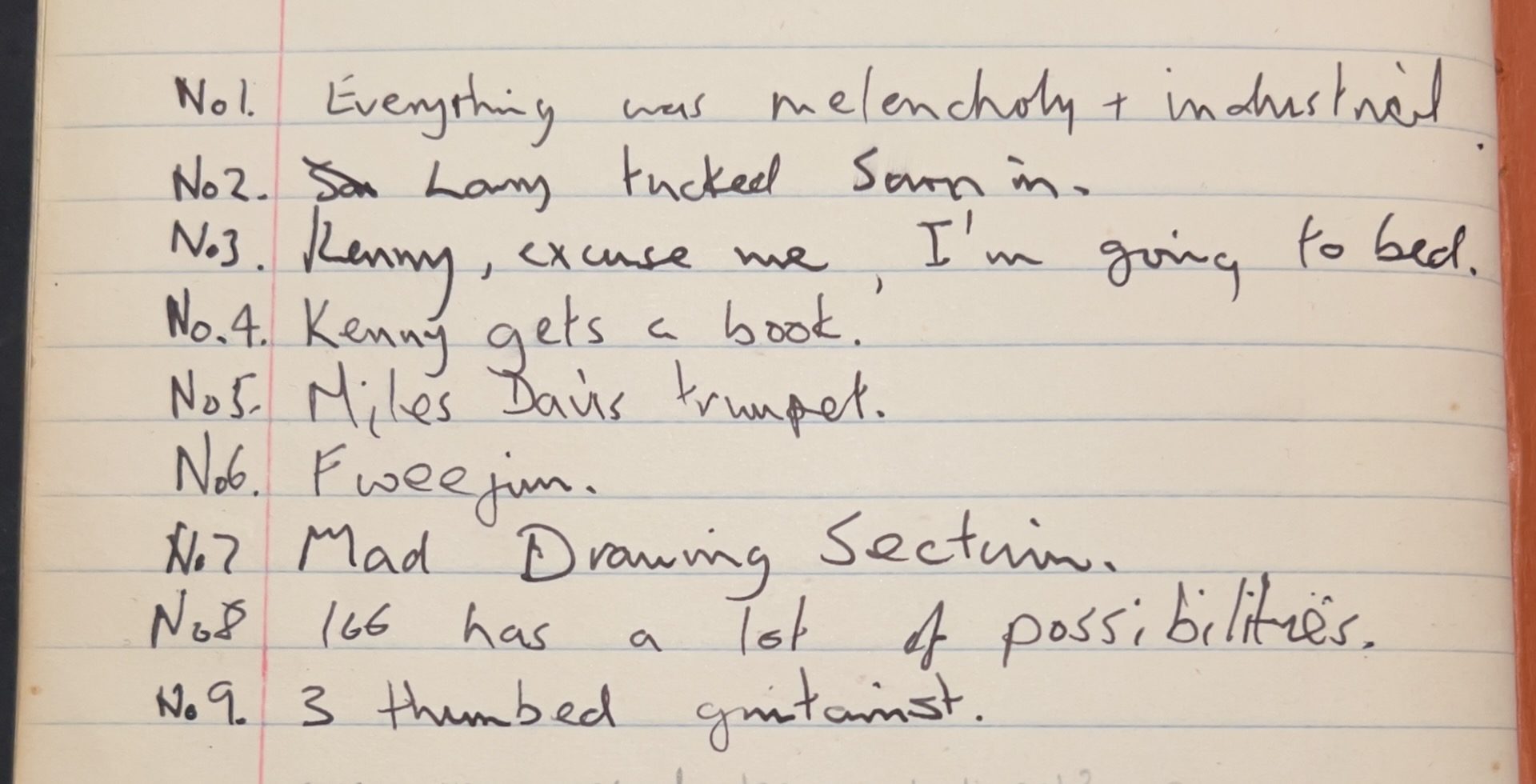
The “shit hit the fan” on my second trip a few years later, when I was back at Stirling. That night I kept notes of this profound experience, which do not make much sense now, but do provide a few pointers which I will attempt to interpret and explain:
No.1 : Everything was melancholy and industrial because we were probably listening to Escalator over the Hill by Carla Bley, not the best choice in the circumstances, but I liked it. It is also possible we were listening to Physical Graffiti by Led Zeppelin, in particularly the tracks In The Light and Kashmir. These notes begin when we had retreated to my little room and I was choosing the music. There was a lot of chaos in the next door flat (of which more later) and I had determined to have a spiritual experience by listening to cool music lying on my bed.
No.2 & 3 : These were my flatmates, also tripping – everyone was, and no doubt we were arranging ourselves in my tiny bedroom, with most people lying on the floor, finding cushions and trying to get comfortable.
No.4 : Any minor interruption seemed freighted with meaning back then.
No.5 : No doubt this was me playing the album Big Fun by Miles Davis, released in 1974, an electronic jazz album with an Eastern drone vibe, and probably the track Great Expectations which goes on for 27 minutes.
No.6 : Fweejum is a made up word that has stayed with me. I was attempting to express the noise a a large vehicle or other object makes sweeping past you, think of it as the imaginary noise that time makes when it is moving very fast, with a doppler effect. Pronounce it without enunciating the letters and you might be getting close to the sense of dropping through the floor, through time and space at great velocity.
No.7 : My flatmates were probably getting fed up with the music and had decided to use the experience to make some unconsciously inspirational art. I have no idea really, it could easily be an imagined drawing in the great dome of starscape enveloping us. Pretty sure I wasn’t physically drawing.
No.8 : Here we are in proper meaningless drug addled territory, there seem to be an infinity or maybe just 166 rabbit holes, blind alleyways or dark caves to plunge into. They multiply as you examine them and it is easy to get confused, you might choose the wrong one. At least it wasn’t 666.
No.9 : By this time I am probably listening to Go Ahead John, the third side of Big Fun and featuring the jazz rock guitarist John McLaughlin. On acid anything visualised tends to mutate and expand, yet seem real.
That was the sensible part of the evening. Beforehand an older and I thought wiser friend, also on drugs, had been violently sick. I looked on dispassionately at the fabulous technicolour mess, containing a wonderful mass of imaginary writhing creatures, just grateful I hadn’t experienced the nausea of feeling the soft organs of my body decide to leave home. Never mix drink and serious drugs I thought selfishly to myself. Meanwhile next door my fellow students were in full on LSD party drinking mode, which soon turned sour. Among our number was a garrulous French student, who spoke perfectly good English. As the evening progressed she was picked on and her every utterance became a source of great hilarity, purely due to her French accent. At an early point I had tried to intervene, to no avail, which was probably when I sloped off to my bedroom to listen to music. At dawn, many hours later, I returned, and she had been reduced to a gibbering wreck, who could no longer speak in any language, completely incoherent. She was truly in a state, yet the barbs continued and I felt powerless by this time to intervene. The behaviour of my fellow students, despite being on drugs, had been appalling. After several days she did recover the power of speech, but I believe she left Stirling and went back to France.
By this time I was trying to look after myself, sleep seemed impossible, life extended emptily, all desire had gone leaving yawning emptiness. That next day I attempted to behave normally and attended a lecture. I was beyond caring, nothing went in and it appeared nothing ever would. I had heard about flashbacks, when you regress to a drug induced stupor, and I was in fear of a slowly repeating chaos. Had I ruined my life? Would this go on forever? Of course not, after 36 hours with no sleep I was simply at my wits end and exhausted. Still it would take a good few days before I re-assembled my life, and determined to slowly clear up my mental state.
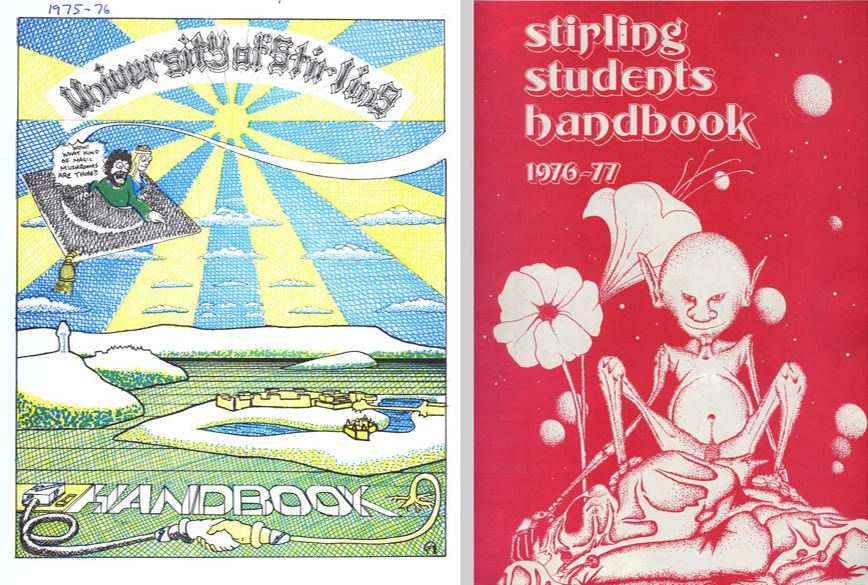
The fact that drugs were everywhere at Stirling can be clearly seen in the covers of The Student Handbook for the years 1975-1977. In addition drugs were openly traded in the Students Union, Alangrange, while the University itself hit the headlines in 1976 when a student broke his leg while “attempting to fly” from a third floor window. The young man broke his leg, and in court claimed he was high on LSD. A few months later, to my horror, there he was in our kitchen high on LSD. I did not think this was a good idea as we were on the top floor. I also vividly remember talking down a minor member of the Royal Family who had taken too many mushrooms. I was a bit annoyed since I had to buy him lunch and midday seemed to be the wrong time to take drugs. He had probably been up all night, I guess. Closer to home my flatmate, who was a big burly motor-biker from Dundee, decided to decorate his room with black bin-bags, which covered every surface – walls, floor and ceiling, and I nicknamed his room the black hole of Calcutta. What started off as a bit of fun soon descended into something more serious, he refused to leave this room and I presume he was taking lots of drugs. A form of psychosis crept in, he didn’t listen to any of us and stopped attending lectures. Suddenly he became obsessed with saving frogs. It was spring and the frogs were migrating across a road from the large lake at the centre of the University. There were literally thousands of frogs and it seemed inevitable a few would be killed on this quiet road. I was concerned enough to try and help my flatmate save some of these frogs, but I soon realised it was a pointless exercise, and that this formerly robust human being was being brought low by a serious mental illness. He disappeared at the end of term, never to return.
After promising myself that my LSD days were over, I believe I did take it once again, but it was a much milder experience, I am glad to say, and have little memory of it. I was lucky, and never did experience a bad trip, but I could easily see how that could happen if taken in the wrong circumstances and without due respect to the dangers. Later in life I did try ecstasy and MDMA briefly at festivals, pleasant but nothing compared to the mind curdling power of the acid trips mentioned above. I had lost the desire to lose control in this way, although I still knew a few people who ended up in hospital due to imbibing so called soft drugs. I certainly do not regret taking LSD, it was a remarkable lesson in the powers of the mind and how sanity can be paper thin. However, much to my disappointment, this experience was no spiritual shortcut. I did not arrive in Nirvana, but maybe discovered there are other ways to get there.
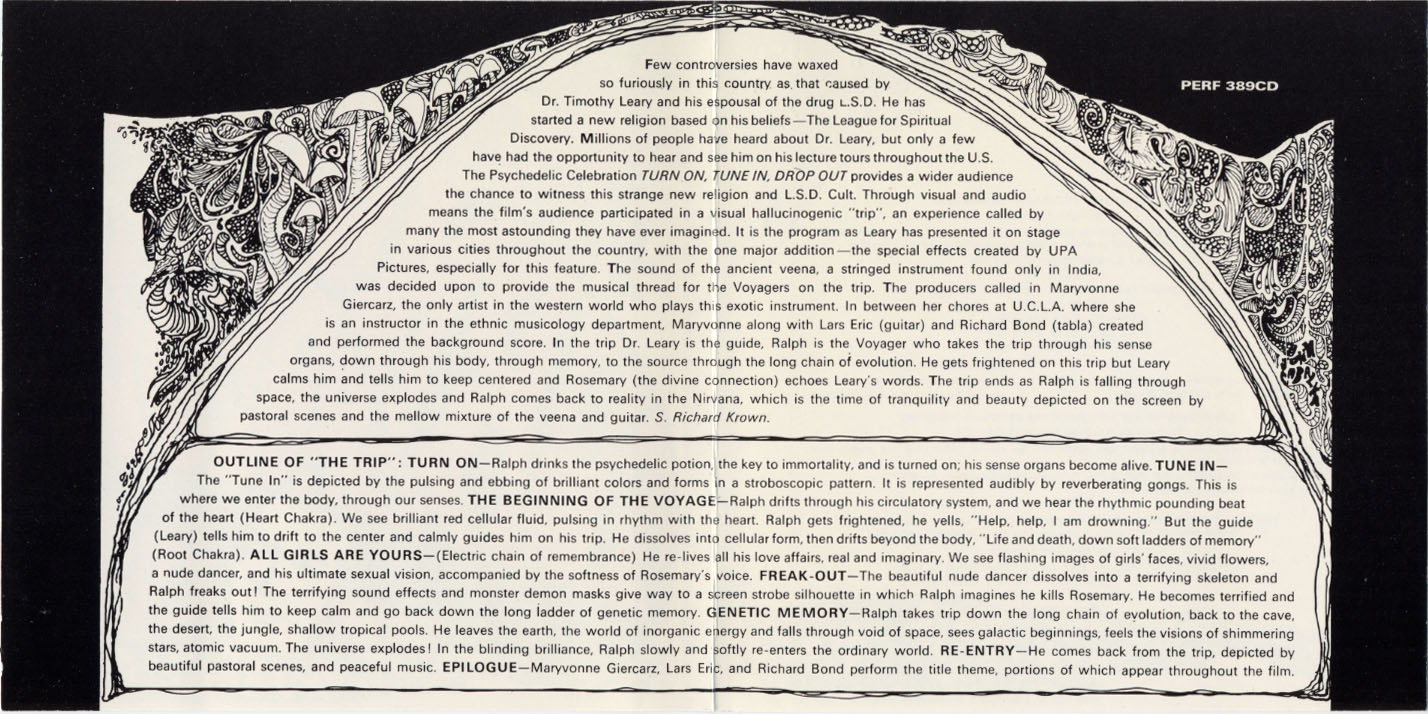
If you want to hear the real atmosphere of these times and the liturgical, obsessive nature of the promotion of LSD listen to Turn On, Tune In, Drop Out by Dr. Timothy Leary, a motion picture soundtrack album made by Mercury in 1967.
Here is a taster from a track called The Trip: Root Chakra:
“…Drift single celled in soft tissue swamp, sink gently into dark fertile marsh, drift beyond the body, float to the centre (I’m Drowning!) float beyond life and death, down soft ladders of memory.”

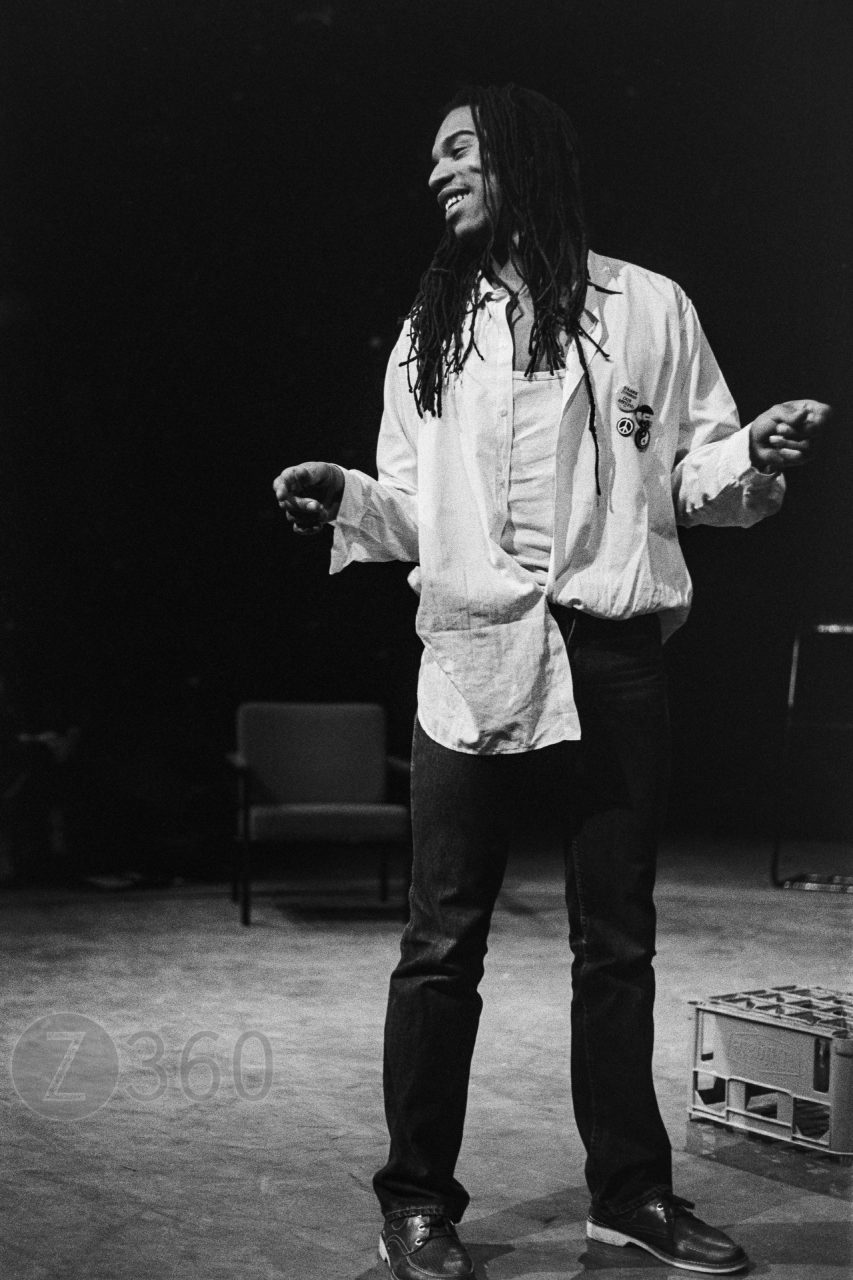
The sad and much too early death of Benjamin Zephaniah this week prompted memories of the first time I saw him way back in 1983 at the Angels of Fire Festival. I was excited to see him since I had heard about him through the New Musical Express, which was my reading matter, rather than the Poetry Review. To put this in context, Angels of Fire was a six night poetry festival featuring new performance poetry and upcoming modern poets, at the Cockpit Theatre near Marylebone. The choice of performers was certainly prescient and varied, since several of them went on to have long careers. This festival of poetry, which gave me an excellent grounding in many different voices, was shaken up by the rockin’ dub protest poetry of Benjamin, which seem like a righteous breath of fresh air at the time.
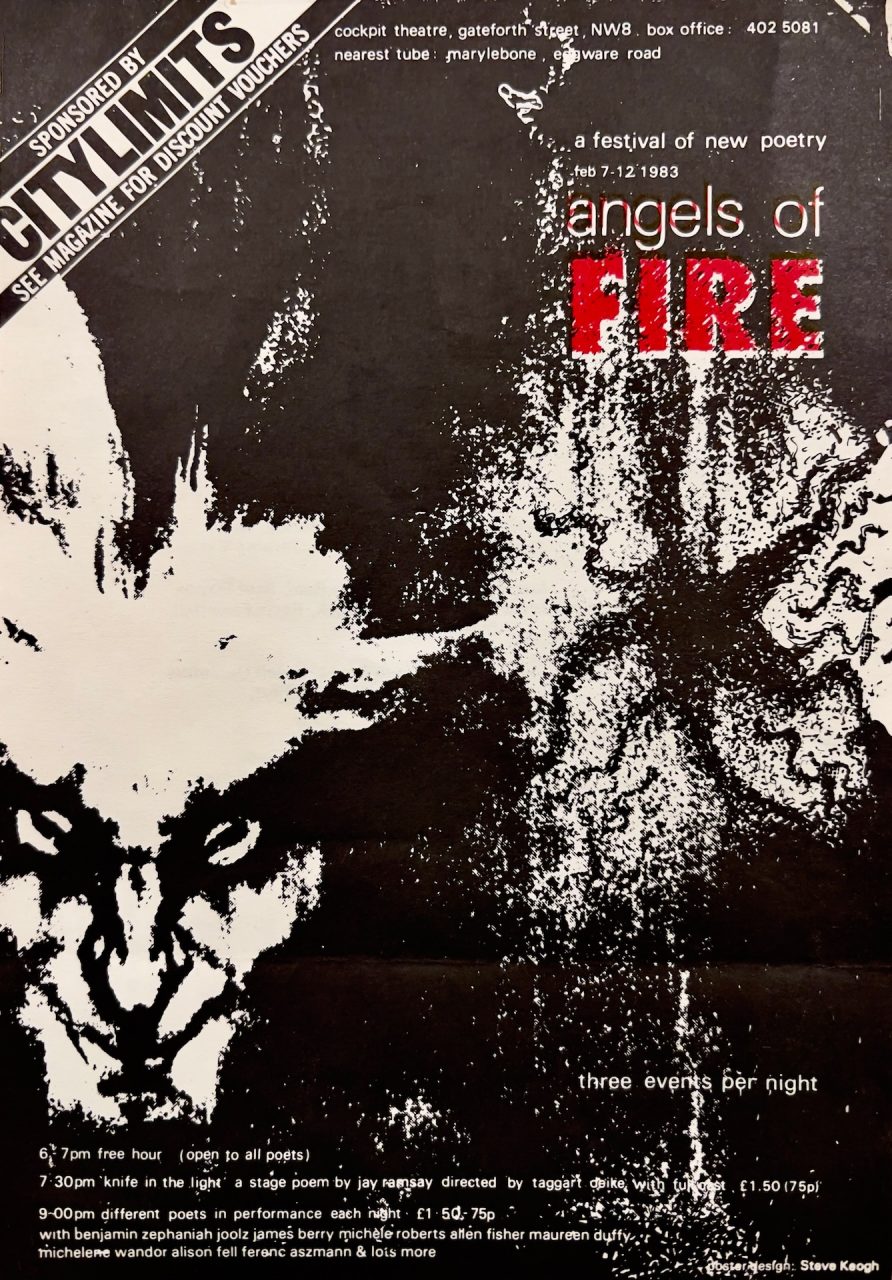
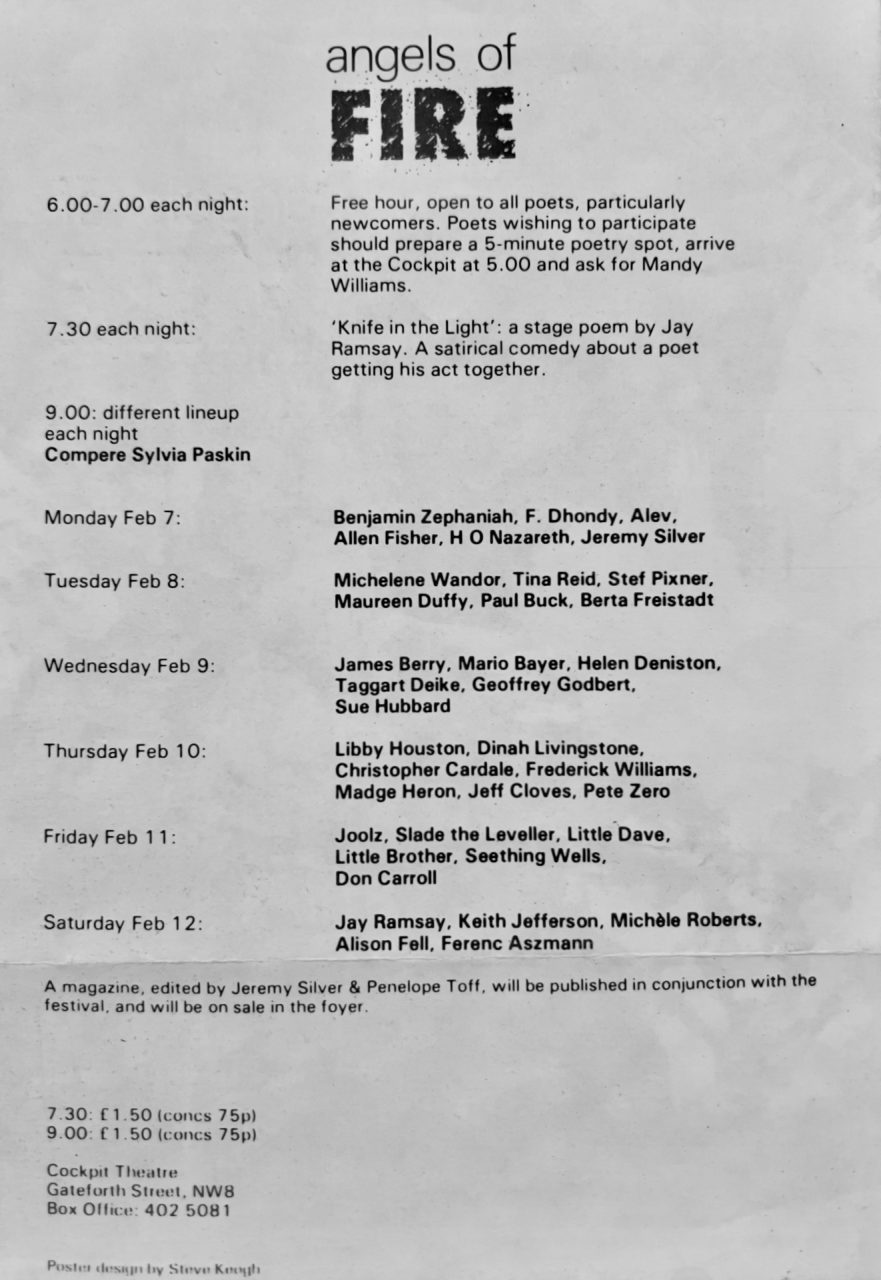
I went to every night of the festival, since I regarded it as my first documentary photography project. I did not really know what I was doing, but was allowed to take photos as a member of the audience (times have changed…). Of course I was not being paid, but I managed to wangle my way in for free for a few nights through British Library Sound Archive contacts, who were recording it. I felt at home there since I had worked at the Cockpit as a Stage Manager. Fortunately the festival was sponsored by City Limits, a London listings magazine, and I made some early print sales, with the photos being used in their poetry column. Eventually some of theses photographs were exhibited at The Drill Hall in Chenies Street WC1.
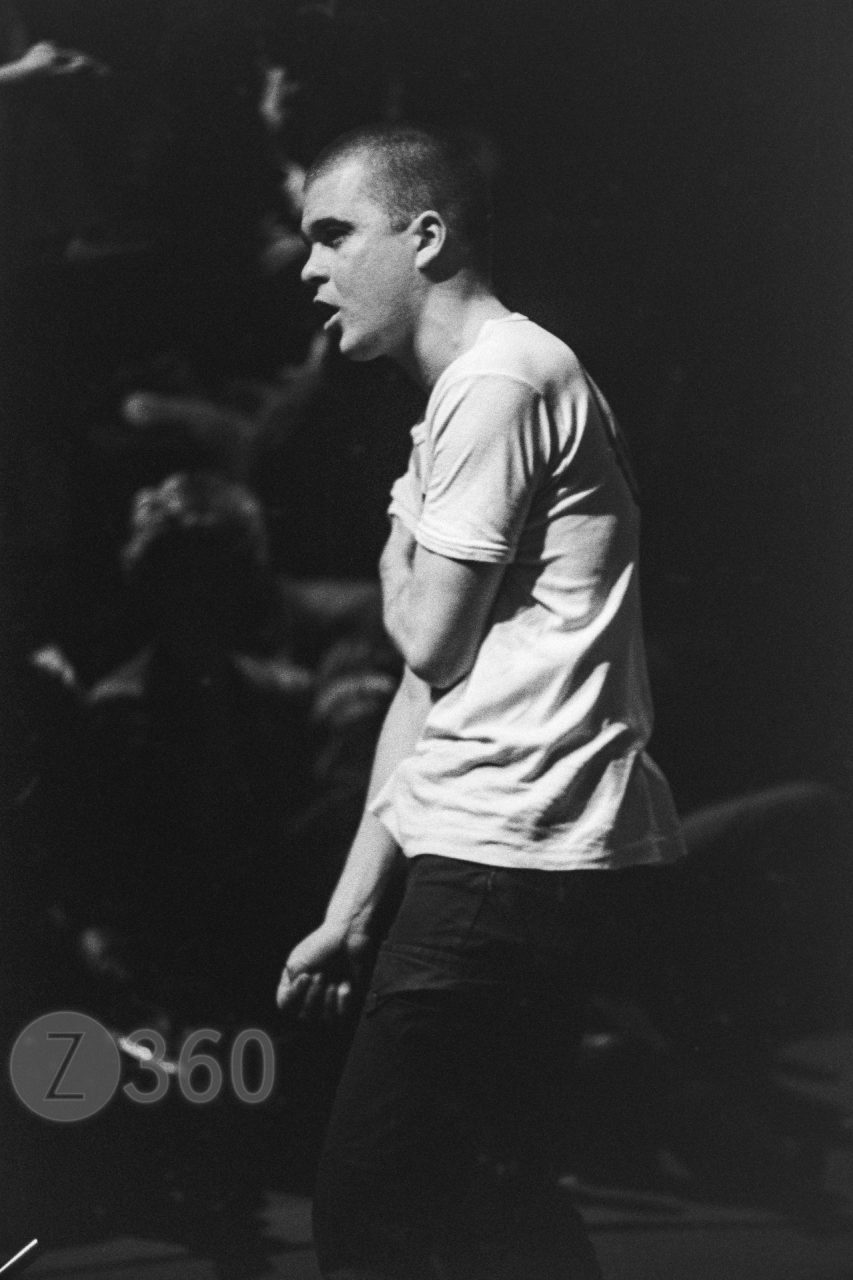
I was also looking forward to seeing Seething Wells (aka Steven Wells 1960-2009), who lived up to his moniker, along with other early ranting poets such as Little Brother and Joolz. The more refined feminist poetic tradition was also represented by Michèle Roberts and Alison Fell, while a notable contemporary wordsmith was Jeremy Reed, full of Bowie references. The world of sound poetry was not forgotten either, with the appearance of the legendary Bob Cobbing (1920-2002), later to be seen at The Klinker in Islington. Here are some of the photographs I took of these poets:
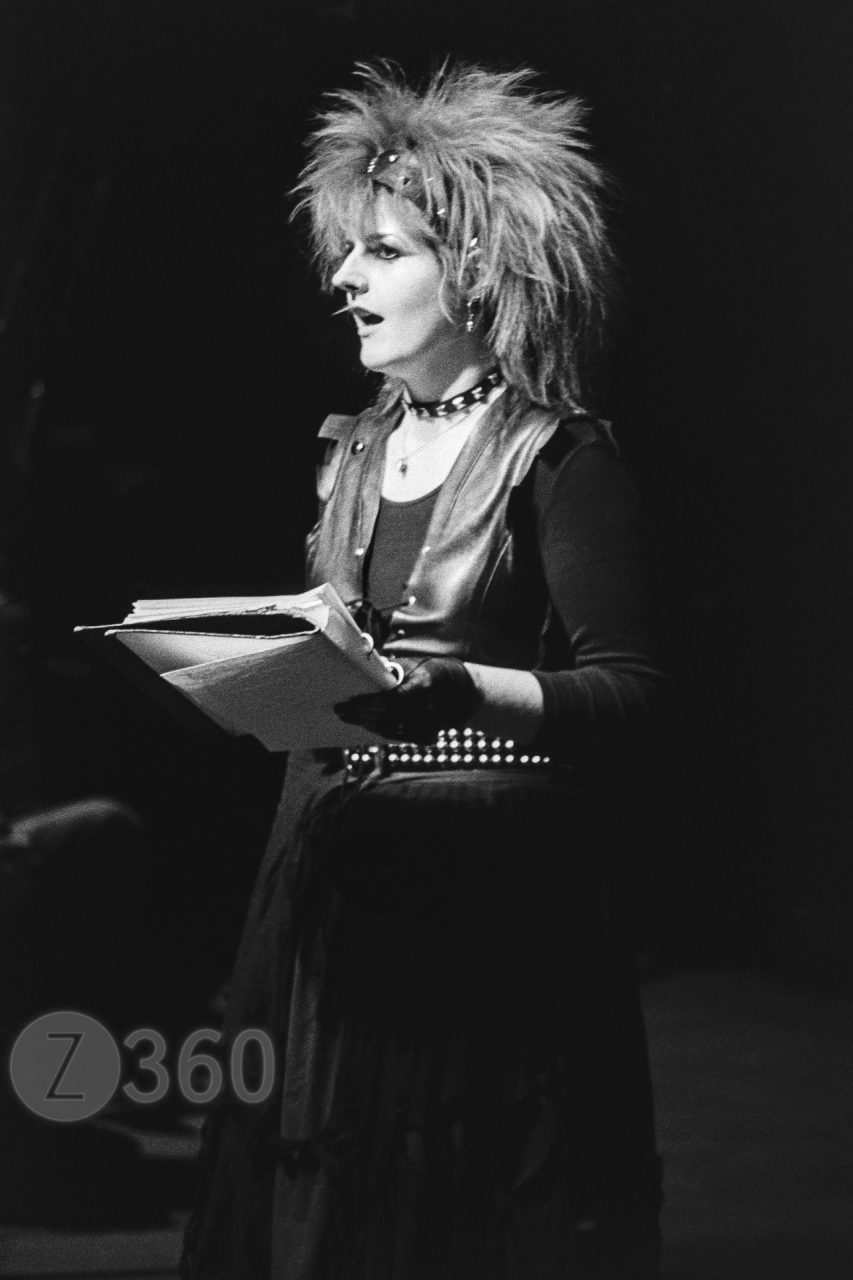
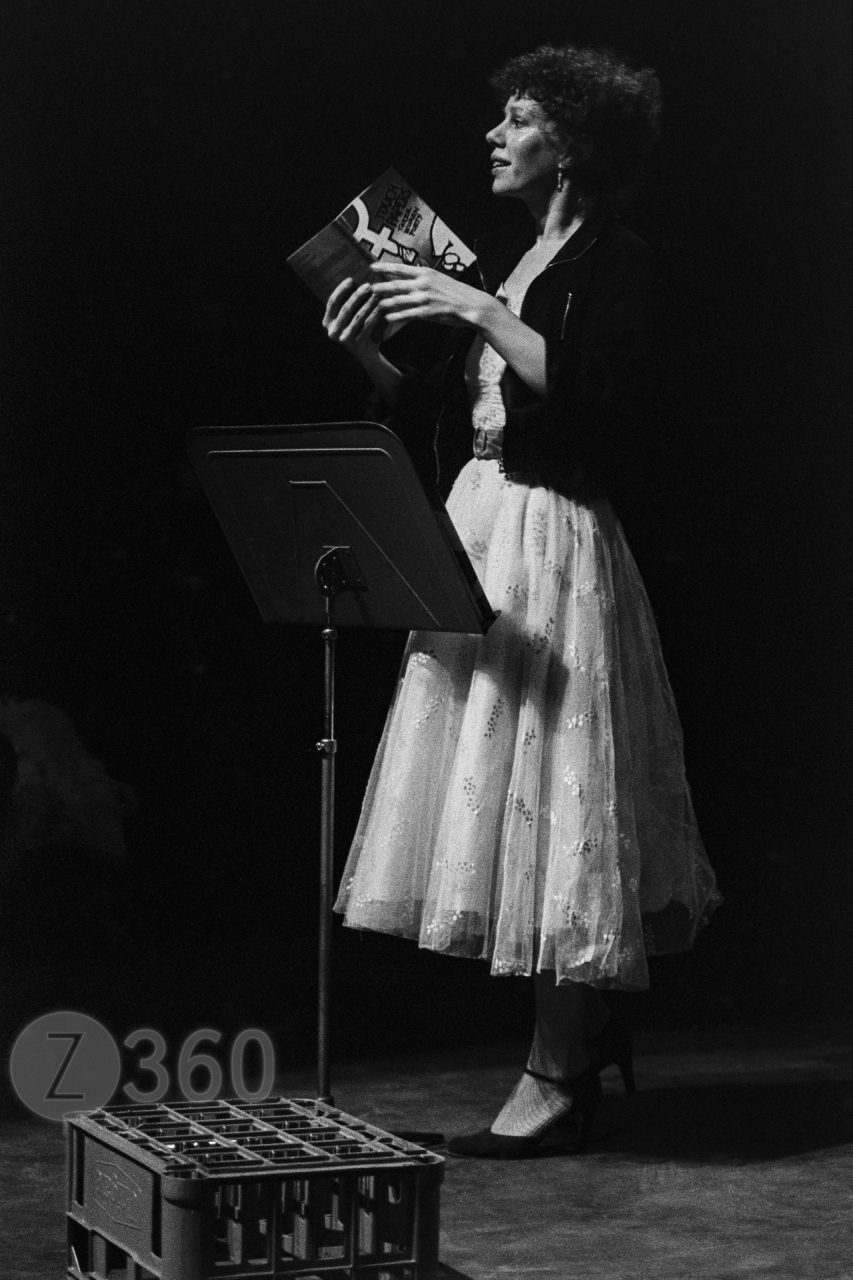
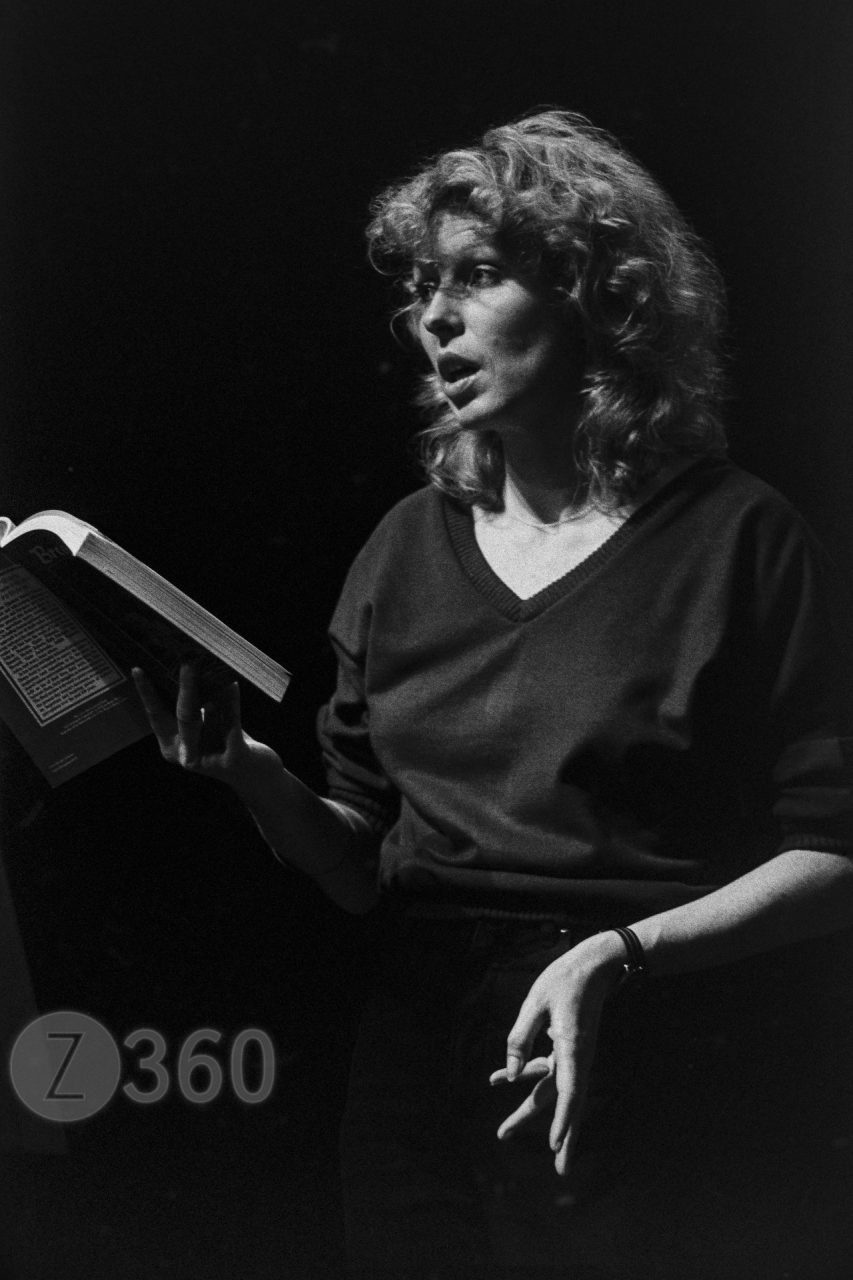
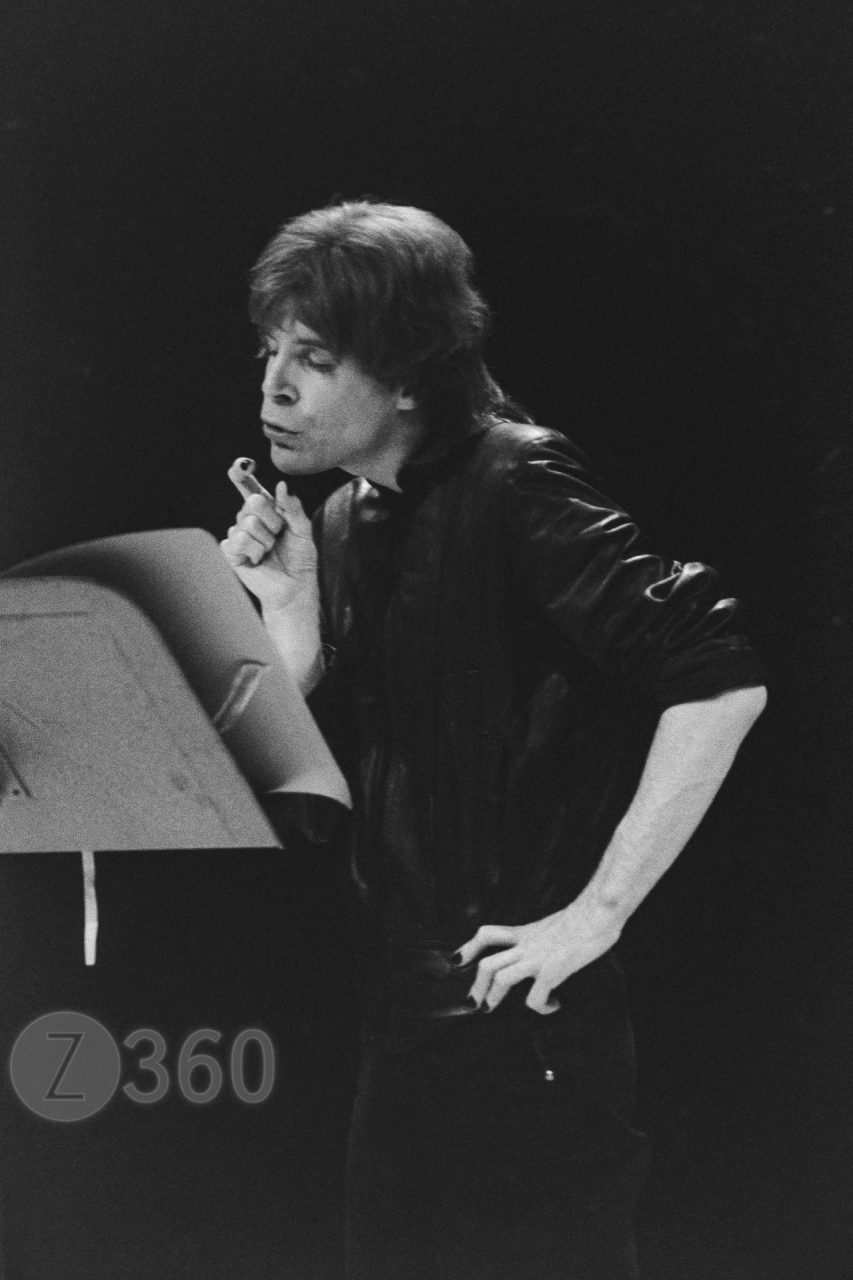
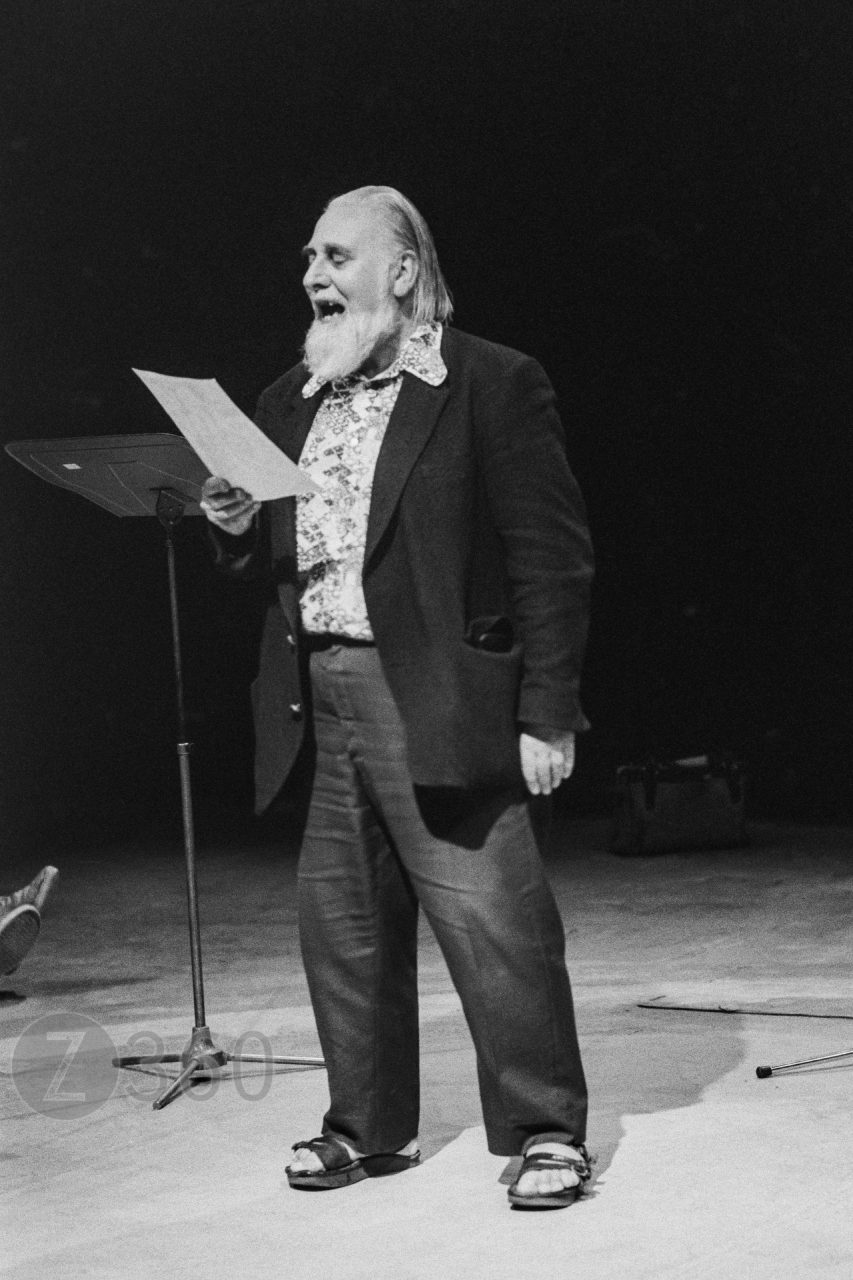
I was heartened to see Benjamin Zephaniah become become a Professor of Poetry and part of the National Curriculum, turn down his OBE, and always act with generosity, wit and humility. Here he is in full flow at the ICA a year later, I believe.
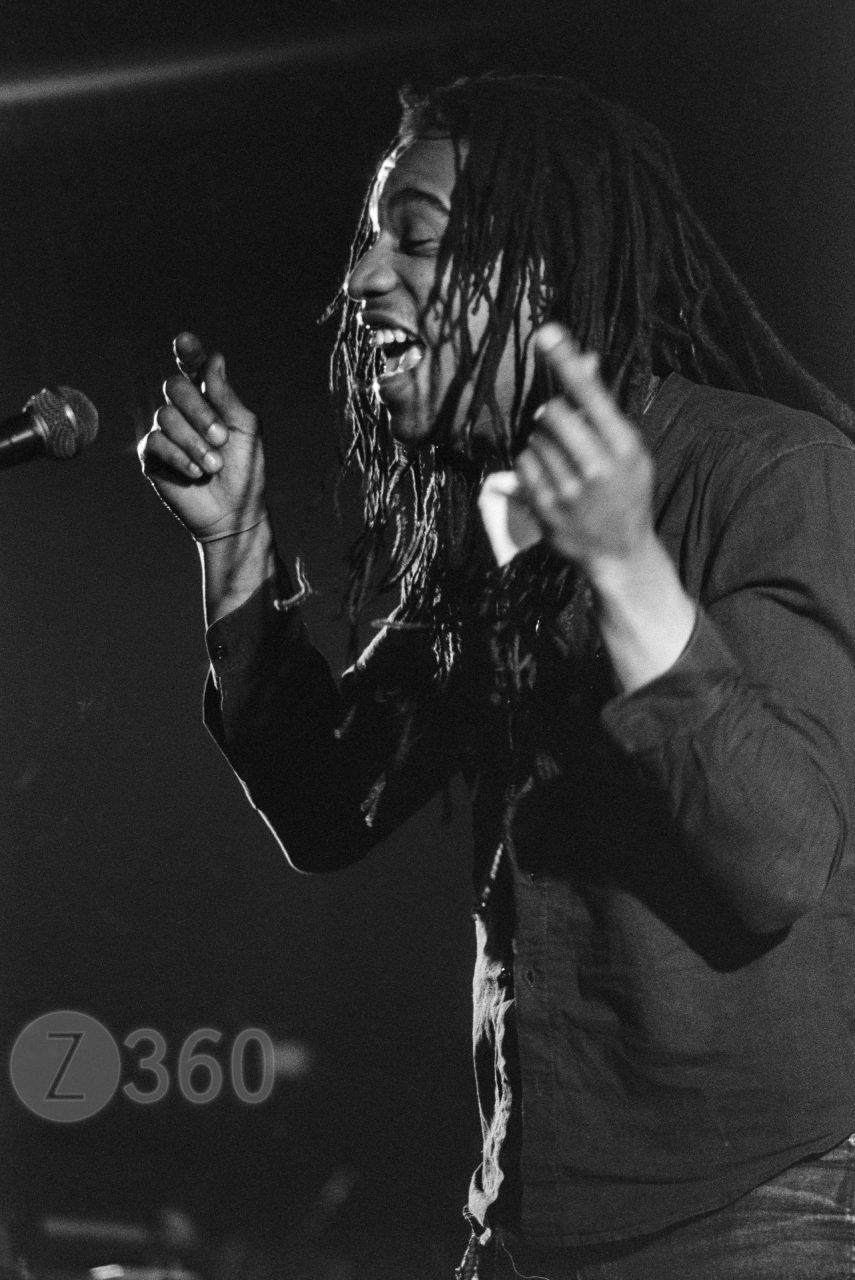
†
I don’t think the word “belief” means anything.
It’s a hovering wobbly, jelly phrase meaning something like:
“I’ve decided to think something’s true because I wish it were true.”
Different Every Time, 2014 – Robert Wyatt

My problems with belief started when I was 8 or 9 at Junior school. We had an excellent form teacher, Miss Laister, whom I trusted and understood. However, one sunny day we had a discussion about Christianity, and we were asked if we believed in Jesus Christ. I wasn’t sure, but he seemed to be popular, kind and interesting, so I was prepared to give him the benefit of the doubt. I felt a bit too young to give a definitive answer and maybe expressed some reservations. It was then that the bombshell in my mind exploded, since Miss Laister kindly told us that it wasn’t a question of supposition, logic, science, history or anything else, simply one of faith. You just had to believe, all your problems and worries would be solved, it was that simple. That was it, there was no other choice. This immediately appeared antithetical to everything I had been taught. Even then, to make this exception for Jesus and no-one else seemed unfair, I would have to investigate further. I was already aware other religions existed, and that for instance Jewish people did not have to attend religious assembly or recite The Lord’s Prayer, so what happened to them at the pearly gates?
Like many of my peers I attended Sunday School, basically biblical study, and engaged with the many fascinating stories. I got hold of a St. James Bible and determined to read it cover to cover, but failed to get much past Genesis, it was not an easy read. Later I was awarded a beautiful red leather bound version of the New Testament, this was bit easier, and I proudly took it along to my Sunday School. From my limited studies I was already not prepared to accept the Bible as the infallible word of God, since I was aware of the many inconsistencies, plain cruelty, changes of tone and competing gospels. Later, aged 11, I had a Christian fundamentalist classmate from Bahrain, who I used to tease with choice quotes from the Bible, asking if he believed in the contradictory and confusing verses I selected. I also vividly remember having an attack of the giggles, if not hysterics, when told the Fishers of Men story from the Gospel of Matthew. This did not go down well at Sunday School, but I would guess by this time I had already decided I would not be confirmed. That is I would not ask God’s Holy Spirit to give me the strength and commitment to live God’s way for the rest of my life. Most certainly I would not be living as a disciple of Christ in the Church of England. I have never regretted that decision. My position at the age of 14 or 15 is demonstrated by the moment when I called Jesus a bastard, not that I wanted to. My good Roman Catholic friend had somehow bet me that I wouldn’t say it before a graven image, yet I felt mentally obliged to follow through on my convictions and did so. I was of course being quite accurate (Joseph was not the father), but my friend believed I was going to hell in a handcart. Such is the power of indoctrination.
Well it was a long journey, via an interest in Western Buddhism during my 20’s, to finally arrive at my own version of agnosticism. Quit simply I agree with this statement: “I cannot know whether a deity exists or not, and neither can you”. Getting to this point may have taken some time, but it was certainly encouraged by one of the bravest books ever written, The God Delusion by Richard Dawkins, published 2006. It was as if I had waited nearly my whole life for someone to take on the exceptionalism granted to religion, this medieval way of thinking, and the lip service paid to plainly outdated ideas.
The whole point of religious faith, its strength and chief glory, is that it does not depend on rational justification. The rest of us are expected to defend our prejudices. But ask a religious person to justify their faith and you infringe ‘religious liberty’.
The God Delusion, 2006 – Richard Dawkins
The person who is certain, and who claims divine warrant for his certainty, belongs now to the infancy of our species.
God Is Not Great, 2007 – Christopher Hitchens
With or without religion, you would have good people doing good things and evil people doing evil things. But for good people to do evil things, that takes religion.
New York Times, 1999 – Steven Weinberg
Those who can make you believe absurdities can make you commit atrocities.
Questions sur les miracles, 1765 – Voltaire
Religion is regarded by the common people as true, by the wise as false, and by the rulers as useful.
The History of the Decline and Fall of the Roman Empire, 1788 – Edward Gibbon (from a quote by Lucius Seneca, 50AD)
The idea that any religious document is the “Holy Word of God”, as is claimed, can now be fully put to bed. Here is a brief resumé of what we now know regarding the great religious texts. The Bible as we know it was formulated in c.367AD during the councils of Hippo and Carthage, and excluded the Apocrypha. The Gospels were written forty to eighty years after the death of Jesus in Rome, they are pseudepigrapha, the claimed author is not the true author. This is the case for the majority of the Bible. None of the authors of the New Testament actually met Jesus. The Old Testament is part folklore and part mythologised Jewish history, formulated in 1400BC, centuries after the events portrayed. For example, there is no historical record of Israelis (Moses and the Exodus) in Egypt. Watch out for Pseudoarchaeology! The Koran has an even more confusing history since Mohammed was allegedly illiterate and it was dictated to him by the Angel Gabriel, this oral tradition only being written down many decades later. The Hadith, “the backbone” of Islamic civilization, was cobbled together from many contradictory oral sources, generations after Muhammad’s death. Strangely Islam posits that God is an Arab, as the Koran is always recited in Arabic, and hence a translation cannot be the “Word of God”. These are the western patriarchal religions for the last 2000 years: Judaism, Christianity and Islam. They come form the same Abrahamic root, use the same basic stories and, given their authorship, cannot possibly be the word of God. We should remember that these religions represent just a moment in our evolution, whose time has now passed. In the Eastern world it is somewhat more complicated since there is no specific word of God, but rather a series of myths, stories and philosophies of life. That is fine, but I was under the impression that myths are not meant to be factually true, so I don’t believe any of that either. The Bhagavad Gita may be a great book, but no-one claims it was written by God, thank heavens.
When you end up not believing in anything (don’t follow leaders…) life can take a strange, slightly dystopian angle, which was encouraged by science fiction in general and the band Joy Division in particular. Like John Lennon (cf. his song God) my I don’t believe list is long, including fairies, ghosts and UFO’s, although they can all make interesting stories. I am a believer in the French principle of laïcité, which separates church and state since the 1789 revolution (confirmed in 1905), and includes the Declaration of the Rights of Man and of the Citizen. This principle does include a right to the free exercise of religion. Still, we all need somewhere to place our own spiritual needs, and obviously the Church no longer managed to fulfil this role for me. I did manage to read a religious book, recommended by my Mother, written by our local C of E vicar. However I could only manage to do this by replacing the word God with the word Gaia (thank you James Lovelock), which seemed to work quite well. I took refuge in the work of Alan Watts, a former Anglican priest who became a Buddhist hippy, and the classic series Zen and Zen Classics (1960) by R.H. Blyth. Later still I spent 4 years doing Tai-chi, which fulfilled many of my spiritual needs, but it’s not a religion. We live in a spiritual desert, where can we put these feelings?
Science appears to hold the answers since it is an open system, constantly being revised. It is empirical, open to scrutiny and genuinely man-made, but is that enough? Certainly the classical religions no longer answer the fundamental questions that led to their creation, science has filled that vacuum. There are many wonders of evolution and nature, yet do they really fulfil our hidden desires for a transcendent belief system? Humans appear to have a millenarian death wish desire, we need to dream and confront an apocalypse, however illogical that may be. Every generation searches for a New Messiah, we all self-dramatise and seem to think we live in the end times, as if history never happened. No-one wants to die, feel their life is pointless, and traditional religion came along to solve that problem. Such is the power of wishful thinking – believe this (or that) and you can live forever in heaven! For a long time we were all a member of an eternity cult. In reality the hope, promise and drama of traditional religion is over, and we await the replacement with some agitation and trepidation. At least there are fewer pointless religious wars, there is no heaven and hell, blasphemy is over, while the churches are empty. And lo, let there be no more self-appointed divine agents, defenders of the faith, no more confession, transubstantiation or apostolic succession. In the meantime, we should all become Secular Buddhists, that is the best I can say.
Reality is that which, when you stop believing, does not go away.
Introduction, 1972 – Philip K. Dick / published 1985
References
https://en.wikipedia.org/wiki/Criticism_of_the_Bible
https://en.wikipedia.org/wiki/Criticism_of_the_Quran
https://en.wikipedia.org/wiki/Declaration_of_the_Rights_of_Man_and_of_the_Citizen
https://en.wikipedia.org/wiki/Secular_Buddhism
Update 30/08/23
The day after I published this article, this was the headline in The Times newspaper, saying only 24% of clergy would describe Britain as a Christian country today.
Update 08/10/24
Just read Rationality by Steven Pinker and I was glad to see he uses the Philip K. Dick quote about reality, referred to above. He makes a strong point about the difference between the mythology mindset and reason, and why we humans are both tempted and fascinated by the myth makers. The book is humorous and pointed, although sometimes repetitious, and there is a bit too much algebra for me. Still it is highly recommended and here is my favourite quote, of many:
Submitting all of one’s beliefs to the trials of reason and evidence is an unnatural skill, like literacy and numeracy, and must be instilled and cultivated.
Rationality, 2021 – Steven Pinker
†
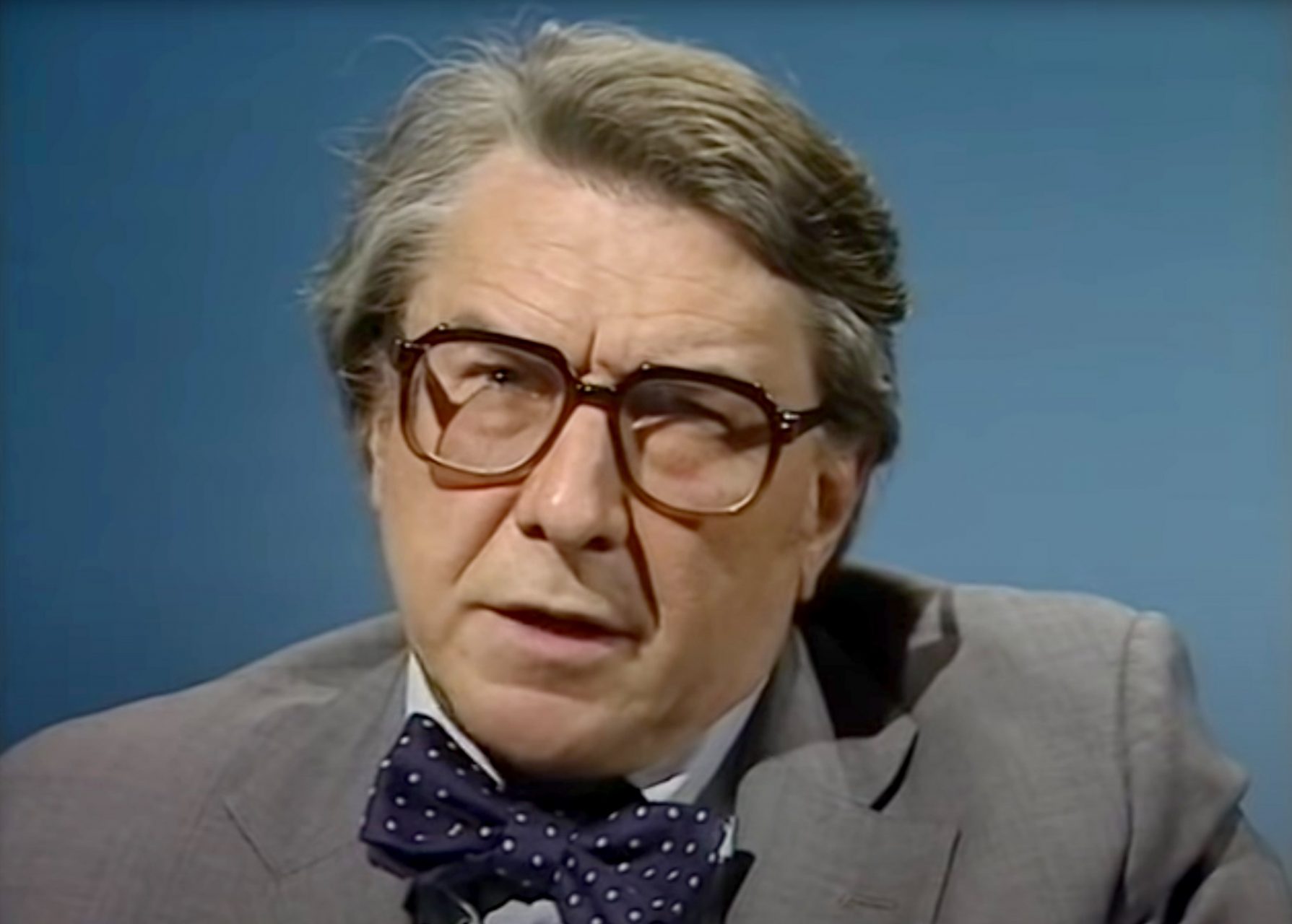
This was my question on the 88th edition of Question Time on April 1st 1982 at the Greenwood Theatre in London.
I invented this question on the actual evening as I entered the building, due to a headline in the Evening Standard that day. We had already posed another question on the invitation weeks earlier. The minute I wrote down this question I felt it had a good chance of being selected, it was right on cue. Even then I knew it fulfilled the brief to be up to the minute.
My question was highly apposite, since our Prime Minister Margaret Thatcher and the American President Ronald Reagan had been spending many millions on installing Cruise missiles at Greenham Common, leading to widespread protests. Reagan would later declare Russia to be an “Evil Empire”, making the case for deploying NATO nuclear-armed intermediate–range ballistic missiles in Western Europe. Yet on this day an Evening Standard headline falsely claimed that Reagan would be reducing the deployment of nuclear weapons, which I believed merited some suspicion, if not downright disbelief.
Sir Robin Day, the host (see above), was magnificent and I was very impressed with the Tory Norman St John-Stevas. During the warm-up with test questions they were both hilarious, but a lot more circumspect when the show went live, to my disappointment. Little known to me at the time was John Smith, later to become Leader of the Labour Party in 1992. The other panel members were MP Mike Thomas, a founder member of the SDP, and Terry Marsland, a feminist member of the TUC.
I wore a very loud and gay pink shirt, so I certainly stood out, and I believe you had to stand up when suddenly you were told to ask your question. For many years, if not decades, people would tell me they had seen me on TV. I had already long forgotten about it, but it was a powerful lesson in the power of the media, since it had been seen by many millions of people.
Of course the response to my question was a lot of humming and hawing, no-one said that nuclear weapons were an insult to our culture, civilisation or even religion, as I wanted them to. No-one came out in direct support of the Greenham Common Women’s Peace Camp, though some expressed sympathy. I thought it was a poor response. Yes, I was a strong supporter of CND at the time and still am. I should point out here, that in 2020 the UK are still spending $6.2 billion every year ($72.6 billions spent worldwide) on nuclear weapons, which could destroy the world as we know it. While I was proud of my question, I gave an anodyne response when the question was referred back to me, which I had not been expecting. This was a very live show at the time. I simply said I agreed with John Smith. Always prepare a witty and cutting answer!

Refs:
Global Nuclear Weapons Spending 2020 https://d3n8a8pro7vhmx.cloudfront.net/ican/pages/2161/attachments/original/1623169371/Spending_Report_ExecutiveSummary.pdf?1623169371
The cost of the UK’s strategic nuclear deterrent 2023
https://researchbriefings.files.parliament.uk/documents/CBP-8166/CBP-8166.pdf
In 1982, at the instigation of Patrick D. Martin, I became the photographic co-ordinator for Robodevco. This later became The Roboshow, where a prototype multimedia computer controlled a forty-three screen, three dimensional sound experience. It was hosted by ‘Q’, a virtual robot at a large warehouse off Torriano Avenue in Kentish Town, London, 1985. It proved to be a “a completely new screen sensation”.
Before the Roboshow there was the Technocab, the most enjoyable part of the whole experience. This was a blacked out London taxi cab containing a Trinitron TV and a BBC computer. Due to the size of the huge cathode ray tube monitor it was a one person experience with binaural headphones, like a solo cinema. The cab would start up as if going on a journey, often dry ice was involved, sometimes we rocked the cab to simulate movement. A taste of what you would see (2 mins in) is contained in the following video, the Roboshow Electronic Press Kit. This low-res video features my stills animated with Bob Lawrie of Blink Productions, as well as the triggered micrographics of Richard Brown.
On the strength of this intense experience nearly a million pounds was raised to fund the Roboshow experience, which was intended to be franchised. A prototype multi screen cinema was constructed and the images would fly around the space in a truly fresh and disorienting manner, after being introduced by Q, a TV robot. Out on location Q was sometimes an American football style roller skater with a video boombox, who featured in the video shot by Charlie Arnold.
The Roboshow garnered a lot of good press, being featured in The Observer, The Face and New Scientist. This description of the show was published in the Evening Standard, January 1987:
“We went into a room that seemed smaller than it actually was because the 20 chairs on the raised platform were pointing towards 50 TV screens that ran around the front and side walls. There was one big screen in the middle.
The lights dimmed.
A rollerskater zoomed straight across our line of vision from left to right with an accompanying sound effect that seemed almost three dimensional. The show had begun– and for the next seven minutes images flickered, jumped, danced and propelled themselves across the screens. Sometimes it was the same picture. Sometimes it would break up so you were seeing the same thing from divers angles on different screens.
It is an experience 50 times as intense as watching regular TV because of the interplay between the screens and the meganess of the sound system.”
These are some of the quotes from the Robodevco Press Pack, which demonstrate why Roboshow garnered so much attention:
“Totally wild … any explanation would fail. to do justice to this experience”
Bruce Dessau, City Limits, Aug 21 ’86.
“The next medium to take over where Cinema left off’
Televisual, Nov ’86.
“Q makes Max Headroom look about as wacky as Sooty”
Direction, Oct ’86.
“Superb -look forward to seeing it in Piccadilly Circus”
Juliet Rix (BBC Newsnight).
“The technical possibilities are extremely exciting”
Roma Felstein (Broadcast).
“Very impressive”
Barry Fox (New Scientist).
“The most important development in Entertainment since they got rid of the Proscenium Arch”
Anthony Horowitz.
This is my photograph of the actual prototype Roboshow in Kentish Town. It was intended to expand the show and run it at Paul Raymond’s Revuebar Boulevard Theatre in Walkers Court Soho, London. Unfortunately this never happened.
It is important to remember that all this was happening before the advent of the internet, digital cameras, HD video or flat screen monitors. In fact analogue video was equivalent to 720×576 pixels at best, that is 625 (576 visible) interleaved scan lines in a 4×3 format. At the time Video 8 with it’s small form factor was the most exciting camera development, but most video was filmed on large and heavy U-matic cameras. Nevertheless The Daily Mirror observed that “the revolution starts here… Shock the music industry and change the world of video”. For an in depth explanation of all this technology the article in The Games Machine magazine, dated August 1987, reveals the many participants and innovations involved:
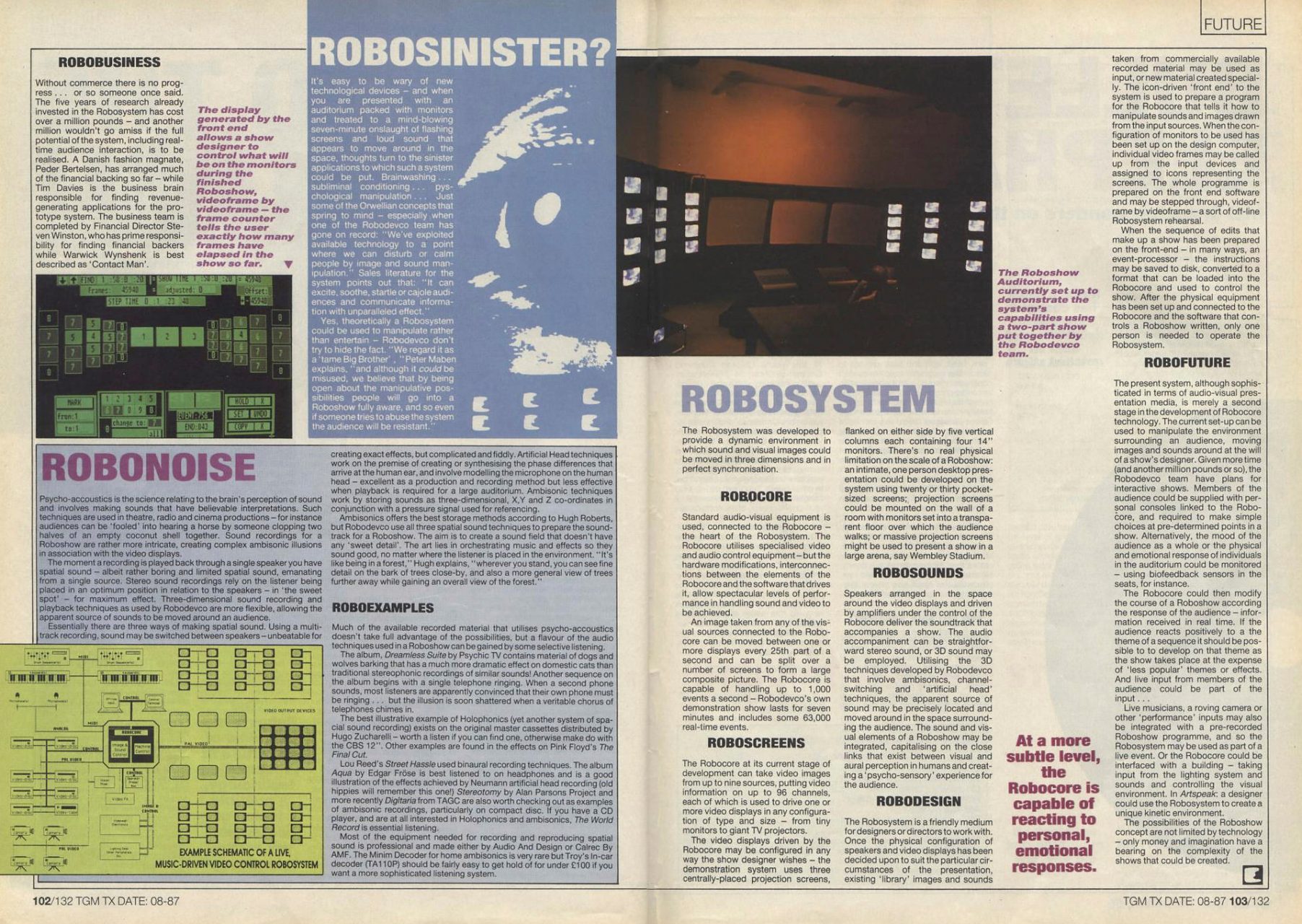
As well as the visuals, audio was an integral part of the experience. A holographic cassette was produced with music by Phil Nicholas, a Fairlight programmer, later to work with The Willesden Dodgers, Stock Aitken Waterman and Def Leppard, among many others.
Here is a promo pic of Patrick Martin, Phil Nicholas and Marcus Kirby taken at Robodevco headquarters:
By 1985 I was fortunately working for New Musical Express and so mostly avoided the machinations involved when new directors and accountants were appointed to Robodevco. The freelance crew (who made the Roboshow) were encouraged to sign contracts to make them rich when the project succeeded, yet were to become liable for large debts as bank guarantors without real equity. Thankfully I did not sign up. Ultimately, after the failure to produce an actual show, this led to arguments about the structure of the project and ultimate dissolution of the company. The directors became XYLO and took the technical assets which opened at a disco called Zhivagos in Darlington in 1988. RIP.
Meanwhile Patrick regrouped and formed Psychovision with a new Technocab, but this time in a Dodge van. I went to the grand unveiling at Chelsea Harbour, but disastrously the new van was not yet finished. Shamefully the many punters were told it had broken down on the Westway. Eventually the Dodge Technocab aka Psychomobile did surface at Covent Garden:
There was some mitigation for the previous disasters when in 1992 Psychovision created a 5 screen show for the Victoria & Albert Sporting Glory Exhibition which was later screened as part of the 1996 Atlanta Olympics. In 2011 Justin Kirby made Roboshow Reboot, a website to document this story, but it has long since disappeared. Here is a brief 44 second clip of my submission for this. It sure all was groundbreaking fun while it lasted…
To conclude here is the full interview Richard Brown made for Roboshow Reboot at the Rewire 2011 conference, which sums up the whole story very well:
From this :
To this – in a few hoarding years :
Abandon hope all ye who enter here!
Meanwhile find the bed…
Destroyed the carpet
Broke the bed
Broke the shower
Broke the toilet
Broke my dinner
and
Flooded the kitchen
Words to the wise – I guess I should have seen the warning signs!
So yes I am partly to blame…
The first point is pointless. I was with the careers advisor at school aged 17 and I did not have the guts to tell him I wanted to be a rock singer. Of course I already knew that to say such a thing would be treated as some kind of joke, if not a reason for him to laugh at me and tell me to grow up. There were no degrees in this subject, and he probably had no conception of what I was not talking about. Still I was disappointed with myself not to raise the subject, not to make the point. In retrospect I realised other errors were made, since I was about to become the Editor of the school magazine. At the time time I had no conception this was an actual job, since once again there was no degree available in this subject. Unbeknownst to me at the time, the correct degree was English Literature, which I in fact did end up partially studying. Yet the idea that this was an actual job evaded me. You could only be a Teacher.
Later I had my big break as an actor, I was to play Iago in Othello at the Oxford Playhouse, sponsored by The Observer. This I managed to do and was quite good, and certainly better than the Zambian playing Othello. Unfortunately he was having some kind of nervous breakdown, having been accused of actually strangling Desdemona. This massive production became a laughing stock when he refused to go within three feet of her, so my performance became rather incidental. After the first night we never saw the Director again, yet there were many more nights of pain in front of thousands of people. Thus ended serious acting.
Another disaster, at least to my mind, put an end to my film career. We had written a touring youth theatre show called The Life and Death Show about the nuclear apocalypse. After many performances we had honed down the Protect and Survive story into a tight and entertaining forty five minutes. This had involved meeting the Secretary of CND, Bruce Kent, and hiding under a table. I was thrilled that this led to making a film at The Albany in Deptford. However this was early days for video, still on reel to reel video tape I believe, and quite simply the Director lost all the audio during the edit! Despite this setback something was recovered leading to a Premiere at the ICA Videotheque. That was all good, but the incomprehensible dialogue sounded like a deep sea quagmire. This naughty Director went on to win many prizes and became a Professor of Film, I never appeared in another film. Such are the breaks, those moments…
Again The Observer was to blame, kind of. I took my huge photographic portrait portfolio into their Art Editor at the ‘Colour’ Magazine (the supplement) and they loved it. To work for them was my dream, so I thought that I had made to the big time, after doing covers for NME and Sounds. It was all close-up black and white portraits, rather in the style of Steve Pyke or maybe even Avedon. However I ended up “second choice”, that is nowhere, and I gave up. Or at least changed my style, I had tried and failed, but of course (in retrospect) I should have tried harder.
The writing was on the wall in 2011 when Tate Britain removed my panoramic tour of Peter Doig from their website, because they were being sponsored by Google. Of course they did not inform me, despite saying “it looks absolutely brilliant”. It was replaced by some fuzzy auto-made panoramas full of stitching errors and incomprehensible angles, the writing on the wall was truly invisible. Yet Jonathan Jones in The Guardian said “Google Street View-style tours of galleries are not to be sniffed at”. He had probably never seen a real panoramic tour in his life. You can’t compete with world organisations working for ‘free’. There is no actual point here, just a gradual decline as Google Street View took over the world, at least in panoramic terms.
That was, in a sense, a list of endings. The high points are not being mentioned here since this article was inspired by the The Last Days of Roger Federer and other endings by Geoff Dyer who makes the point that whole lives can turn on a sixpence, or, at least in terms of tennis, on a single point.
•
Of course it wasn’t a skirt but a kilt, but to everyone else but me, it was a skirt. I was age 10 at Farnborough Road Junior School, Southport, on summer clothes day. Was I bullied? You bet and I expected it. This was a challenge which I paid for, punched to the ground, constant skirt flipping. Much to the disappointment of my tormentors I had serious underpants on, unlike my grandfather.
He was a London Scottish soldier at the trenches in World War One and was regularly inspected to make sure he wasn’t wearing any, which was “illegal”, and a sign of enfeeblement. A few lashes would fix that. Later I noticed a fab tartan pair of boxer shorts he had, but they were from his dress, not army, kilt. I still wear them (as not visible above).
I was so proud of my kilt and wee sporran, bought by my grandfather in a splendid shop along the Royal Mile in Edinburgh. I took the blows with flamboyant outrage, and I would guess none of my school chums had ever seen a kilt, apart from my Scottish friend Maurice. I was well aware of the notional provocation. I also had a Sgian Dubh, a ceremonial stabbing knife kept in the sock, but thought it wiser not to take it along. This black dagger had not gone down well at Sunday School. Although it could have come in useful!
Years later I wore shorts to my senior school, it was summertime. I was pilloried by my adolescent peers in long trousers. What a hoot! Don’t zig, zag. Have confidence. Always a joy to be different.
 Well it was the M1 Mac I had been waiting for, so on announcement day I plumped for a Mac Studio with M1 Max, 24-core GPU, 32GB of RAM and 1TB of storage. The migration from a Mac Pro 2010, 2×3.46ghz and 96GB Ram went smoothly considering I was coming from the 2018 Mojave 10.14 system. As you can see I am using all the ports on the back, grateful for their inclusion. One of the main reasons for this update was simply to be on a modern and supported system, yet I am hard put to find any useful improvements in the system software.
Well it was the M1 Mac I had been waiting for, so on announcement day I plumped for a Mac Studio with M1 Max, 24-core GPU, 32GB of RAM and 1TB of storage. The migration from a Mac Pro 2010, 2×3.46ghz and 96GB Ram went smoothly considering I was coming from the 2018 Mojave 10.14 system. As you can see I am using all the ports on the back, grateful for their inclusion. One of the main reasons for this update was simply to be on a modern and supported system, yet I am hard put to find any useful improvements in the system software.
In fact I am disappointed that there are still so many glitches after all this time, there should have been plenty of time to iron all these out. Firstly it took the Music app 40 hours to re-index my iTunes library after several crashes. In addition the Music app still appears to be in development, being unable to scroll artwork, so this is all you get, half a picture, and the rest is missing:

No Scrollbar !
Surely it can’t be that difficult to make a scrollbar like we had in iTunes. In addition you can no longer drop music into a playlist – it appears briefly then disappears. I then have to go and hunt for it in the Recently Added Playlist. Of course I was also faced with the plethora of permissions issues, simply to use an attached disk, slowly I am overcoming them. My Keychain refused to transfer, so I was forced to use Two Factor authentication, despite Apple saying it was optional, still dealing with issues arising. It then took 12 hours to update Final Cut and X-Code, while Apple System Status said everything was OK – oh no it wasn’t! On the monitors front the system regularly refuses to respect my 2 monitors, forcing everything onto one screen, especially after trying (it takes several times) to sleep the computer. I was plagued with the notorious flickering HDMI connection initially, making the 4k monitor run at 50 instead of 60hz, seemed to assuage the problem, but not an ideal solution. This problem has now been resolved, but the Sleep function appears to be broken. I was also surprised to see the spinning beachball so regularly on this fast computer, in particularly just looking up recent items can cause it. I had none of these problems on my 12 year old Mac Pro, so I was expecting better.
There have been lots of minor changes for the sake of it. Overall there are some improvements with connectivity and the neural engine, yet in day to day usage the computer is not much faster than the old Mac Pro, despite the hype and carefully chosen speed graphs. I would call it incrementally faster, seconds here and there, some things still take a long time! The neural engine certainly makes video encoding a breeze, that is many times faster. I have noticed the computer settling down after a few weeks usage, this may be due to Trial aka triald which uses machine learning to improve usability. This is good but apparently allows parts of macOS to be automatically updated regardless of your settings, which I am not so keen on. There are also some documented problems, which I have avoided or worked around such as the issues with kexts (kernel extensions) which are being deprecated, but can still provide useful functionality. Yet, since the Library is now locked , you can no longer delete old, unused kexts! It should be noted that MontereyOS still cannot provide SMART monitoring of external disks without a kext. It is also now nearly impossible to make a proper backup disk of your system. Of course I had to lose all my old 32 bit apps and regret the loss of iView Media Pro and several disk repair apps. I have found a useful replacement for Media Pro in Photo Mechanic Plus, but there is a lack of repair and analysis apps for M1 Macs. More seriously there appears to be a variety of issues with the Thunderbolt ports, which do not give the advertised speed of 10GB/s for USB3.1. If in doubt use an expensive Thunderbolt 3 or 4 enclosure as I had to (see OWC Envoy Express 2TB NVME SSD above). My favourite Mac Guru Howard Oakley says: Lack of support for 10 Gb/s SuperSpeed+ in USB 3.1 Gen 2 is arguably the most serious failing in what has otherwise been a very successful transition.
A part of me thinks this is all a brilliant sales pitch to make us buy new computers. Simply refuse all updates to the old ones, tell us they are no longer supported and slowly make them incompatible. Yet people have still managed to take old Mac Pro’s past the 2018 Mojave system, by hacking and “illegally” installing newer systems. Why can’t Apple themselves do this, if the hardware is capable?
Despite all the aforementioned I would still recommend an M1 Mac (see Do not buy an old Intel Mac). Things can only get better!
Update 26/05/22
Bargain Samsung 32” 4K Monitor for £250!
I bought a Samsung M70A monitor for only £250, matching my much more expensive BenQ PD UHD monitor. It was cheap since it has been superseded by the M80. This is allegedly a smart monitor and does have USB-C, but I have resolutely switched off all the smart possibilities and ended up with a 100% sRGB display. A few caveats: there is no proper profiling, but using a Spyder Pro monitor colour calibration tool it now looks great and runs full sRGB 3840 x 2160 @ 60.00Hz. In addition, despite being sold as a 32” monitor, it is only 31.5”, still Samsung make cheap good looking screens.
PS. If you require the sRGB Colour Profile to make this a good monitor drop me a line!
Due to popular request I am listing my albums of the year, that is the ones I have listened to extensively. This is an eclectic list, starting with new albums and then drifting off into reissues or older albums re-discovered. I hope you find something of interest.
 Floating Points, Pharoah Sanders & The London Symphony Orchestra: Promises
Floating Points, Pharoah Sanders & The London Symphony Orchestra: Promises
A truly contemporary chill out album combining electronica, masterful sax playing and gorgeous orchestration. You can hear the six decades of jazz history in the playing of 80 year old Mr Sanders, so relaxed yet so authoritative, I would have liked even more. A unique and wonderful combination of talents, the beauty makes you want to swoon.
Arooj Aftab: Vulture Prince
Another slow burner from this Brooklyn-based Pakistani composer and singer. At times reminiscent of Nusrat Fateh Ali Khan, the singing is peaceful and plangent. There is a an overlying senses of sadness, but it is not cloying or without movement. Many of the lyrics are based on the Ghazal, an Arabic poetic form steeped in loss and longing. A ghazal may be understood as a poetic expression of both the pain of loss or separation and the beauty of love in spite of that pain, says Wikipedia.
Mdou Moctar: Afrique Victime
Burning guitar, as if Hendrix had joined Tinawaren. This is a powerful album to be played loud, packed full of galloping riffs from the Azawagh desert of northern Niger. I had the pleasure of seeing him a few years ago at Cafe Oto, you can see the pics here.
Hedvig Mollestad Trio: Ding Dong. You’re Dead.
The discovery of the year and the gig of the year. Instrumental Rock-Jazz combining the Goth sensibilities of her Norway home and intense guitar shredding. She manages to sound totally original, with a huge vocabulary of psychedelic and jazz riffs, constant excitement. She plays with a huge sense of élan, yet never forgets the atmospherics. This is a proper power trio with bassist Ellen Brekken and drummer Ivar Loe Bjørnstad together in HM3 since 2011. Wow, what a night, as you can see here.
The Coral: Coral Island
A delightful album using spoken word and pop songs to take you on a journey to Coral Island, a seaside resort with ballroom, funfair. pier and a werewolf. The charming story songs seem like a throwback to more melodic times. Of course it all reminds me of my home town Southport, not surprising since they are from Hoylake, just across the Mersey on the Wirral Peninsula.
Olivia Rodrigo: Sour
It’s the popular choice! If you’ve had enough Fiona Apple, Taylor Swift or even Lana del Ray then try this. Yup the kids have been lapping this up and I enjoy the yearning, the swift changes of pace and the vocal gymnastics. Proper pop entertainment from California.
Robert Plant & Alison Krauss: Raise The Roof
Perhaps not as strong as their classic Raising Sand from 2007, the chemistry is still unique. It is strange to think that the bombastic vocalist of Led Zeppelin has become such a sensitive singer, and paired with the golden tonsils of Alison Krauss, the contrast is often very moving. The odd mixture of country, rockabilly and blues is very relaxing.
Sly & Robbie meet Nils Petter Molvær: Nordub
Well this was released in 2018, but I’m still playing it regularly. It is included here in memoriam to Robbie Shakespeare, who sadly died in December 2021. They were a unique rhythm section, playing on many reggae classics as well as with Serge Gainsbourg, Grace Jones and Bob Dylan to name but three. To find out more about Nils, see my blog.
Max Richter: Voices
A unique album setting readings of The Universal Declaration of Human Rights to music. It is both ghostly and moving and flows along beautifully. As the voices and instruments intermingle a genuine aural landscape is constructed, without being cloying or didactic. In 2021 Max released an instrumental reworking of this album called Voices 2, but I prefer the original – with the voices!
Journeys In Modern Jazz: Britain (1965-1972)
Yes they are still making Jazz compilations in 2021, and this one is very well put together and sounds remarkably contemporary. Several of the tracks would be very hard to source and it’s great to hear them fresh and remastered. Strangely we thought that British jazz lived in the shadow of the real guys in the US of A, this album gives the lie to that, being both funky and adventurous. Big rediscoveries were Don Rendell and Ian Carr, and especially the great closing track by Michael Gibbs. Heavy!
Bob Dylan: Man On The Street
This is a weird one, being a 10 CD package which I presume is a bootleg, or perhaps it is out of copyright. Still it is available on Amazon right now for a mere £22. All these CD’s contain the radio broadcasts, home recordings and live concerts from 1961 to 1965, famous to any bootleg collector. Thus you get the contents of the first ever bootleg, Great White Wonder, as well as his 1961 Carnegie Hall gig and the 1965 BBC recordings. They sure sound better than the versions I have heard over the years and contain many unreleased tracks and hilarious interludes.
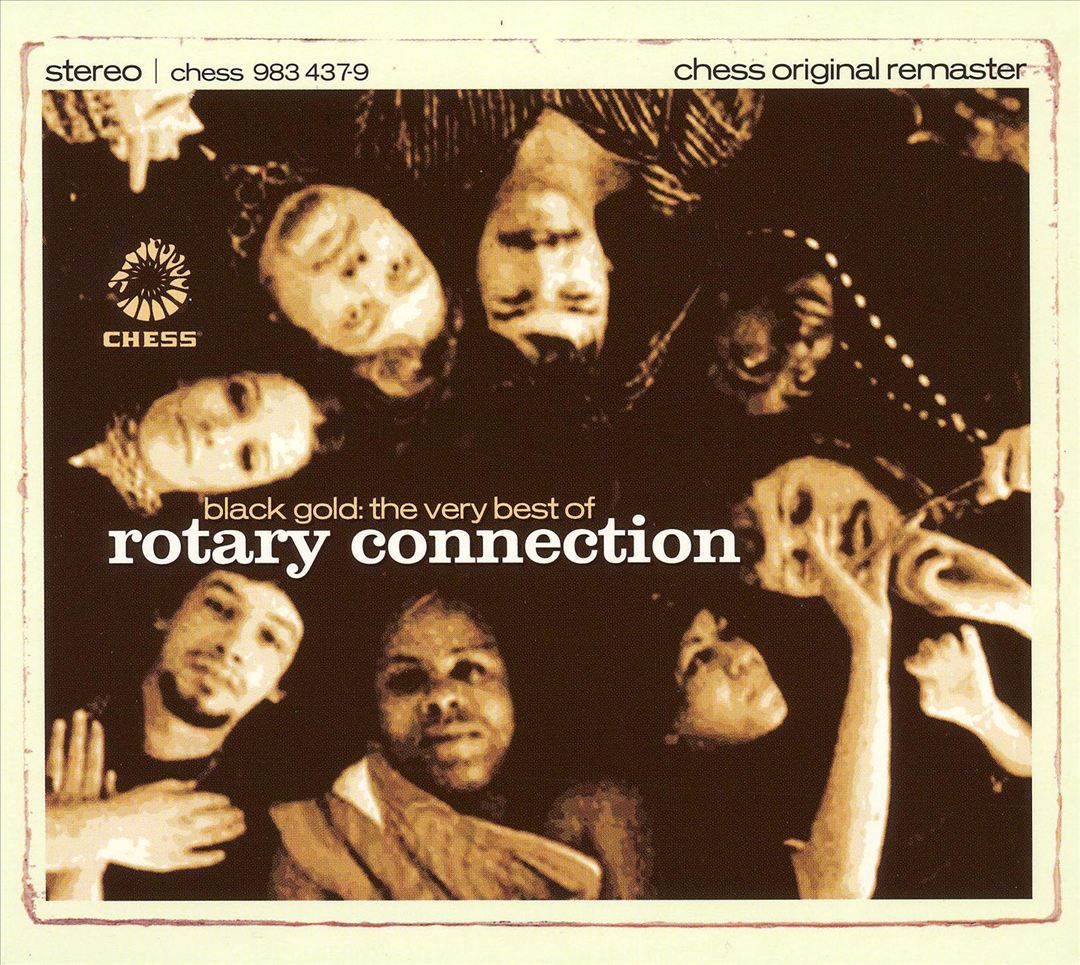
Black Gold: The Very Best Of Rotary Connection
This was my soul epiphany of 2021. Of course I knew ‘I Am The Black Gold Of The Sun’ from many raves, but was not aware just how crazy this band was. I thought they were lightweight and not funky enough, but I was coming from the wrong direction. They were a truly psychedelic choral soul band, with an amazing arranger in Charles Stepney and a world class singer in Minnie Ripperton. During the years 1967 to 1971 they took soul music and made it epic with massed choirs and orchestras, covering rock classics from Hendrix, Cream and The Band. They deserve their own church.
Gustav Holst: Choral Works
A recent discovery recorded in 1984 and composed 1908-1912. It was a great solace during the lockdown when singing was outlawed. Most of it is a predominantly female choir with the harpist Osian Ellis and it is very dynamic. My reference point was the work of David Axelrod and albums like Earth Rot, although this is much more ethereal. The singing itself is very rhythmical and builds to powerful climaxes, very satisfying and quite strange.
The Lost Jockey: Professor Slack EP
Another result of lockdown was the digitising of some rare vinyl albums from my vast collection. This 10″ EP was my favourite, recorded in 1982. The Lost Jockey were the British answer to the systems music of Philip Glass and Steve Reich. However they seemed to be much funnier, poppier and funkier to me, and I held out great hopes for them. I was so keen on them I even wrote an article about them (unpublished). Still this EP, full of restlessness despite the pulsing, was as good as it got. Their solitary full album was a disappointment, although several members went on to have very interesting careers with Man Jumping, The Shout and on the ZTT label.
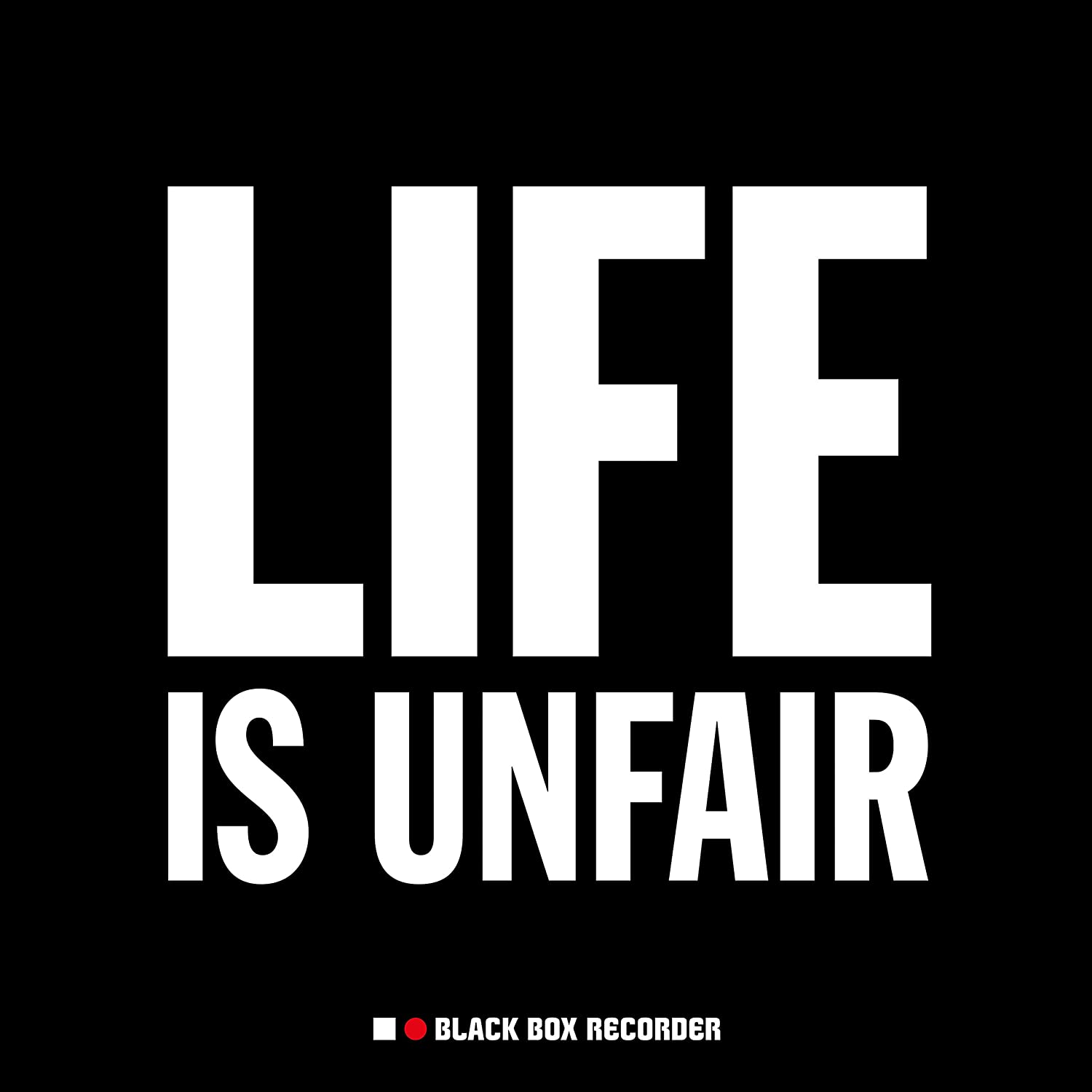 Black Box Recorder: Life Is Unfair
Black Box Recorder: Life Is Unfair
Totally missed this group 20 years ago, although I was aware of Luke Haines, but found him a bit arch. Yet with the addition of Sarah Nixey on sensual and domineering vocals it all seems to work, the irony of the lyrics arrows straight home. They really are the funniest English group ever, the black humour skewering school, motorways, sundays and, in their only hit, the facts of life. This is the 4CD box set of all their albums with a free poster.
~